Garden Diary - July 2008
If you have any comments, observations, or questions about what you read here, remember you can always Contact Me
All content included on this site such as text, graphics and images is protected by U.S and international copyright law.
The compilation of all content on this site is the exclusive property of the site copyright holder.
Perennial Plant Association in Philadelphia
21 through 26 July 2008
Please note: This is extremely picture-heavy. There are 240 images.
Accordingly, it is very slow to load. Your patience is appreciated
as I attempt to find a way to speed things up. Thank you.
Use links below to jump to specific topics.
And if all of this is not enough, jump over to Garden Writers' Get-Together in Philadelphia.
Another year, a different conference. Take another look at some of the same gardens,
and peek at different ones, all displaying the horticultural riches of the Philadelphia region.
Omnium Gatherum
Wherein I gather up various tidbits and oddments that didn't appear somewhere else.
Nothing extraordinary, just things that took my fancy.
Monday, July 21st - Urban Gardening and Public Landscapes Tour with Pennsylvania Horticultural Society
Bridge views from Penn's Landing
.
Tuesday, July 22nd and Thursday, July 24th - Perennial Plant Association trade show

Emma at the Timber Press booth
Barry Glick gesticulating at his plants
A mannequin in vegetated clothing, one of Simple's and Michael Bowen's creations

Hot new echinacea cultivars cooling off in a very outsize martini glass
Friday, July 25th - Estate Gardens of the Western Suburbs tour
Shortwood, the garden of perennial diva Stephanie Cohen
An arbor, designed by Simple that enhances the tool shed
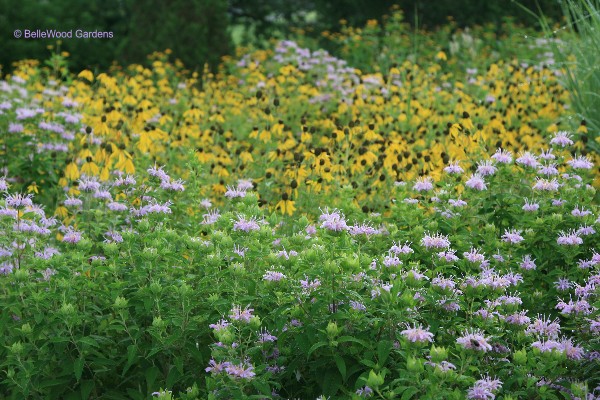
Prairie planting, installed several years ago using Superplugs from North Creek Nurseries
Waterloo Garden Center
Very important sign

Who knew there were so many fertilizer variations
Ellen Talmage, garden diva, with Nepenthes. She's driving home.
Saturday, July 26th - Bucks County Estates and Gardens tour
W. Atlee Burpee at Fordhook Farms / Heronswood
This is a Heronswood beauty, Schefflera arboricola
What a leaf!

And speaking of foliage, how about this frosty combination:
Japanese painted fern, Athyrium niponicum 'Pictum' and lungworts.
Back to Top
Dinner at Linden Hill
Our time is drawing to a close. The Perennial Plant Association's 26th annual symposium began on Sunday, July 20th with optional pre-conference seminars. July 21st offered optional tours. The conference proper began on Tuesday with a day of lectures, followed on Wednesday with a day of tours. More lectures on Thursday, and the formal conference drew to a close. We, the eager plant geeks hung on for a day or two more of further tour options. But now it is Saturday evening and all good things must come to an end. But what a finale, with a fabulous dinner at Linden Hill Gardens, catered by DiSh Catering across the Delaware River in Frenchtown, New Jersey.
A server fills glasses with white wine mellowed with a slice of ripe peach.

The inviting table of appetizers did not look this pristine for long.
I think my favorite was the shaved Parmesan cheese on a slice of baguette,
drizzled with a thick balsamic reduction. So good! There was more
on the other end of the table, out of view. A couple of creamy dips and
cherry tomatoes, good food that was quickly devoured by the hungry hordes.
The well-provisioned bar was self-serve for both wine and the kegs of beer.
A water slide had been set up on Mt. Linden, amply enjoyed by members of the band
who would be entertaining us after dinner. No pictures of that food - I was too busy
eating cold poached salmon and a deliciously filled wrap, potato salad, and more.
There was seating in the magnificently restored barn at Linden Hill Gardens, or
we could wander outside into the balmy summer evening air.

Someone discovered a kayak on the pond, and went for a leisurely paddle.

And dessert . . . . now, dessert was s'mores.
You don't know about s'mores? Clearly then, you were
never a girl scout or a boy scout. They're part of a scout's training.

First, you need marshmallows and graham crackers. These marshmallows
may look strange if you're used to the drum-shaped commercial products. These, you see,
are organic marshmallows made by DiSh Catering so they were poured into a pan
and cut into rectangles. Fit the graham crackers better, too.

Chocolate is also important.
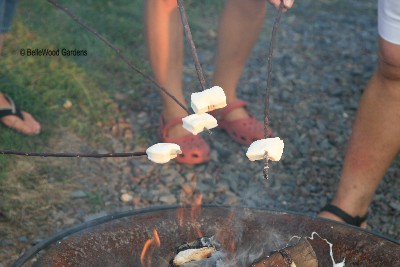
Use a stick to toast the marshmallow over a real fire.
Don't carbonize it, just get the marshmallow soft and gooey.
Quickly now! plop the marshmallow on a graham cracker.
Quickly lay the chocolate on top of the marshmallow, top with
another graham cracker and eat it up right away. Do it right
and the warmth from the marshmallow will soften the chocolate
into a delicious, gooey confection. Nothing like it, and a
wonderful finale to the meal, the day, and the conference.
Back to Top
Linden Hill
We finished the day at Linden Hill Gardens, where long-time Perennial Plant Association
member Jerry Fritz has his garden design business on a historic farm in Bucks County County, Pennsylvania. Display gardens include a 300-foot long shrub and perennial border along the road, pond plantings, a deer-resistant garden, and more offer much to see and enjoy. There are selections of rare and unusual plants for sale, and handcrafted garden accessories.
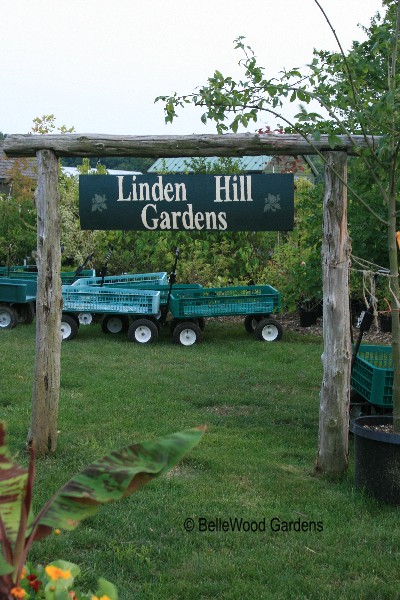
.

Off the bus and gather round, as Jerry welcomes us and describes the schedule.

Welcome to us all.

The gardens are embellished for our delectation and delight,
floating flowers in a basin, and in a magnificent stone trough.

.
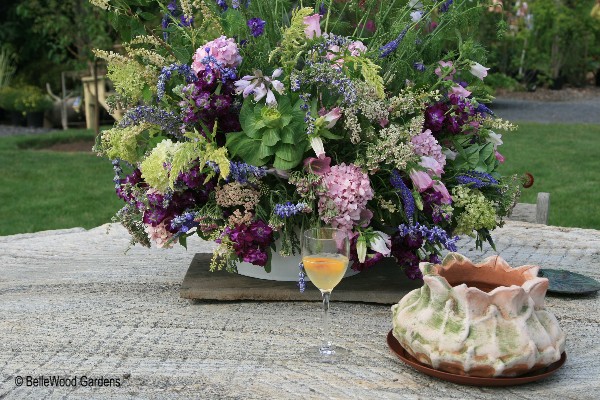
A lavish bouquet on a millstone table. It would not surprise me
to learn that all the flowers were cut here on the grounds.
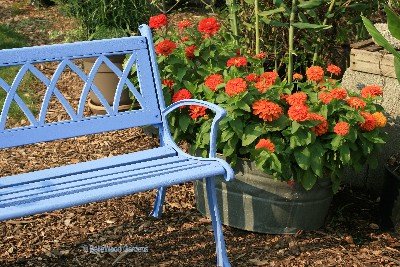
Attention to detail, with a sky-blue bench set next to a tub
filled with exhuberently orange zinnias. Great combination, and how well
the zinnias are growing. But no time to sit, there's more to see and enjoy.
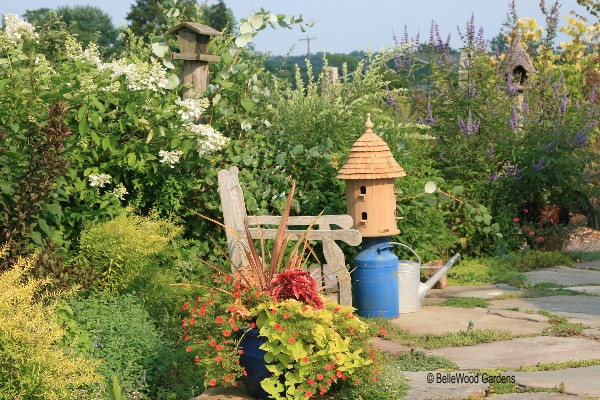
An inviting little patio nook with a bench and some birdhouses.
Like the thatched version, the one atop a blue milk can, or the little feeder
on a post? They're all for sale and what takes your fancy can come home,
airline regulations and your budget permitting.
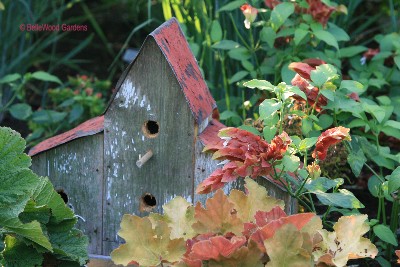
Set on the ground, I cannot decide if it is a bird house or one
where the fairies come to say. Adore the color matching in its placement
with shrimp plant, Justicia brandegeana, and Heuchera 'Caramel'.

Or this superb pairing in the Great Border along the road where
snowy white daisies pair with a shrubby willow gilded by the setting sun.
Just a little vignette from the 300-foot long, very deep border. Attention to detail.
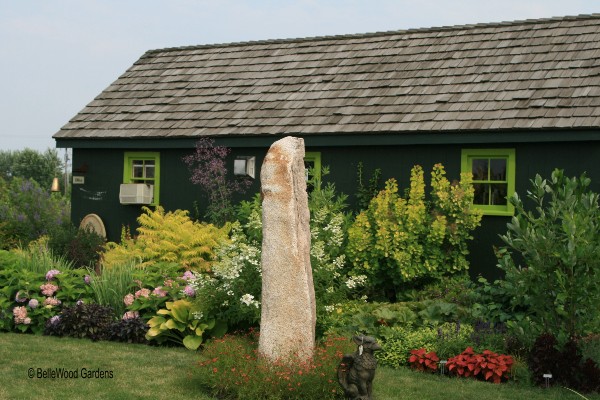
One of the outbuildings, its window frames painted a vivid
chartreuse green that plays off the golden leaved shrubs and accents
of red and purple foliage in the border at its base.
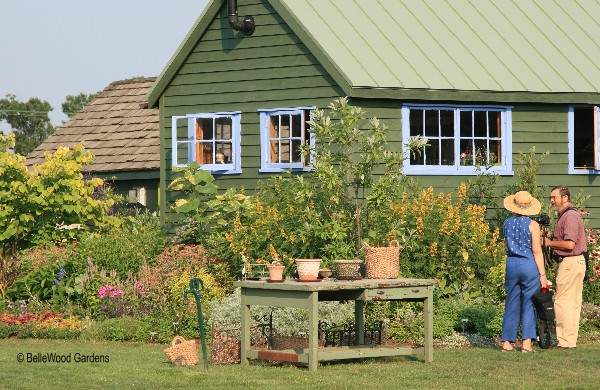
Brent and Becky Heath of Brent and Becky's Bulbs in animated conversation.
This shed, the shrub and perennial border continuing with similar colors,
has soft blue painted trim, and looks equally elegant.
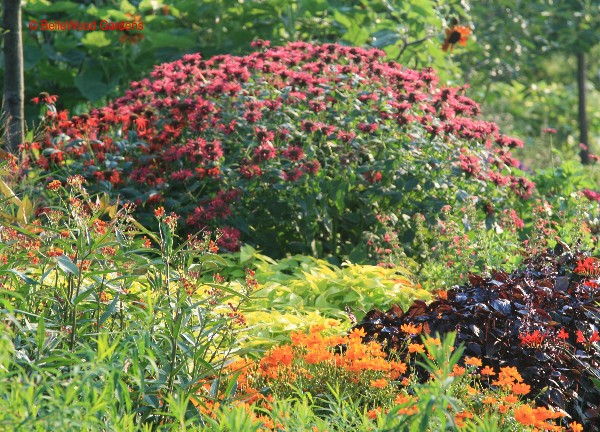
A hot border where red- and orange-hued flowers hold sway:
monarda and crocosmia, fiery Sunset Strain cosmos, purple leaved alternathera.

Some happy people: Dale Hendricks of North Creek Nurseries,
our host, Jerry Fritz of Linden Hill Gardens. George Ball of W. Atlee Burpee Company,
our genial host for lunch at Fordhook Farm. And on the right
Dan Heims of Terra Nova Nurseries, the world's source for heucheras
and pulmonarias and any variegated plant you can think of.
And allow me to assure you that the rest of us were just as happy
as these four smiling gentlemen. A very good ending to a very good day.
Back to Top
Mill Fleurs
When our group arrived at the serene and peaceful gardens of Mill Fleurs in Pipersville, Pennsylvania it was difficult to believe what we were told came before. The first step, when the property was purchased fifteen years ago, in 1993, was to remove bamboo from the site. A daunting challenge, it required 7 workers, 2 backhoes, and 2 weeks of intense labor. Add in a steep hillside down to the water and a vertical stone cliff above the driveway, and "challenging" becomes a defining term for this young garden. The grist mill and adjacent lumber mill on Tohickon Creek date back to the 19th century, with the former built in 1842 and the latter in the 1890s, renovated into a unique and special home.
There are several diverse areas along the dogleg path that zigzags down the hillside: collections of Epimedium and Hosta, seven different cultivars and species of Pachysandra, and more. Beds are color-themed, with groupings of pink and pink with burgundy flowers welcoming visitors as they enter. Burgundy, both foliage and flowers is another collection, with other groupings of golden grasses, glaucous blue conifers, and much, much more.
With thoughts of a book in our hostess' mind, we were asked not to publish any pictures that might conflict with this goal. I asked, and was graciously granted permission to share plant portraits here at BelleWood Gardens. Enjoy this bouquet of blossoms at Mill Fleurs.
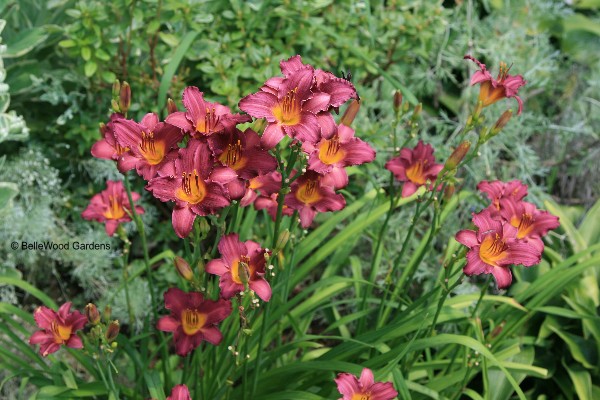
Daylilies are a popular addition to the red and burgundy flower beds.

Their variations add liveliness to the composition.

A charming combination pairs a dark-leaved dahlia, possibly 'Bishop of Llandaff',
with some dill that's gone to seed. I love the airy, wispy, misty look
of the feathery herb against the dahlia's strong color and form.
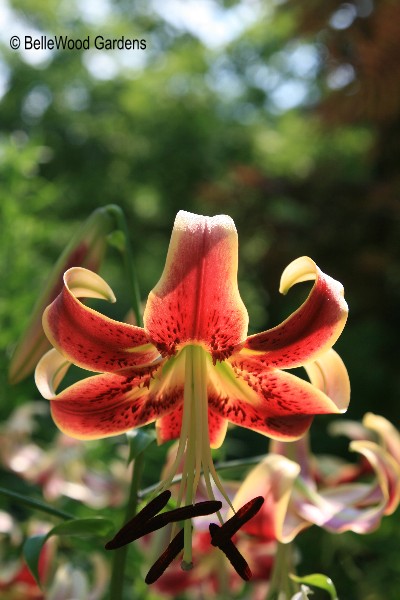
A speciosum lily, beautifully backlit by the afternoon sun.
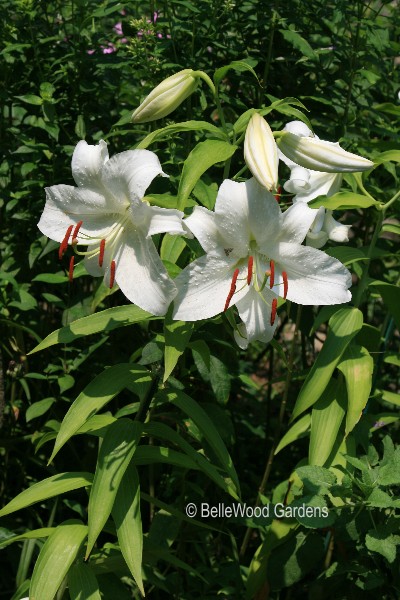
Lilium speciosum var. album
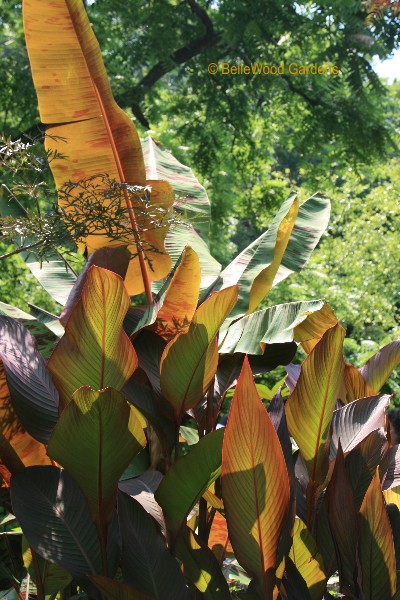
Canna and banana. Which leaf is which one?
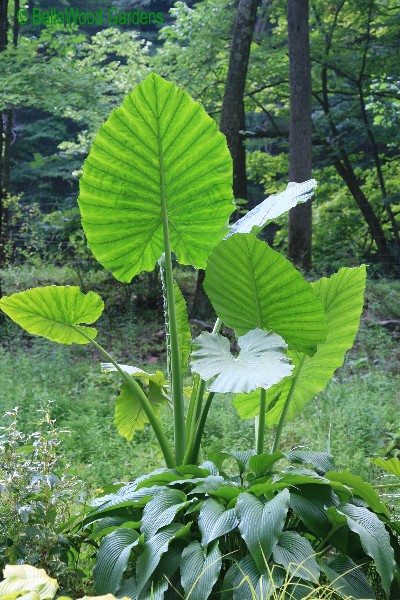
An amusing combination places masses of hosta at the feet of an elephant ear.

Help me Rhonda . . . . I know there's a hosta and a fern, but
deciphering my scrawly notes seem to indicate that the gorgeous dark green
maple-leaved plant is something like Cacalia delphinioides. And apparently
there ain't no such plant. Anyone out there who can help me out? I want it.

I grew Clerodendron trichotomum in my Wilton, Connecticut garden, probably close
to its limits of hardiness. It's quite happy here in New Jersey, bigger and bolder.
The flowers are followed by metallic blue berries, held on reddish calyces.
Bruise the velvety leaves, and they smell like peanut butter.
Happy in light shade and responds well to pruning. Suckers, a lot.
Back to Top
Twin Silo Farm
Serendipity. We were supposed to go to a different garden. It was up for sale, there was a binder on it, and obviously busloads of perennial plant enthusiasts are not what buyer, seller, or real estate agents would appreciate. Kudos to Jerry Fritz, local site co-chair, who arranged this alternate visit to Twin Silo Farm in Doylestown, Pennsylvania. Of course, the fact that his company Jerry Fritz Garden Design was involved with both properties just might have had something to do with this. Lucky us.
The property encompasses over 100 acres of which more than half is maintained as a gardens. There are gardens of roses, a maze defined with tall privet hedges, landscaped vistas with specimen trees, an alle� of sweet gum, Liquidambar styraciflua, fountains and statuary and gazebos and more.
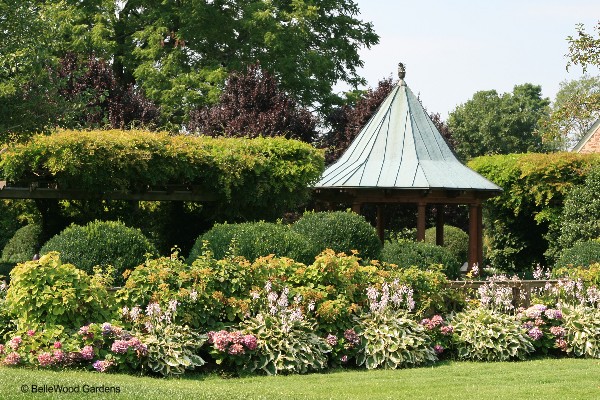
Approaching the house there is a very pleasant vine-covered arbor
walled with clipped boxwood, hydrangeas, and hostas, with a small
but elegant gazebo with a verdigris witches hat roof as a focal point.
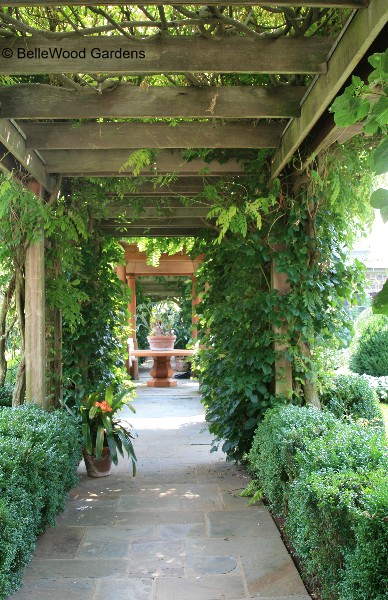
From within, the sheltering arbor invites the visitor to stroll
along the shady flagstone walkway, perhaps pausing to admire the view.
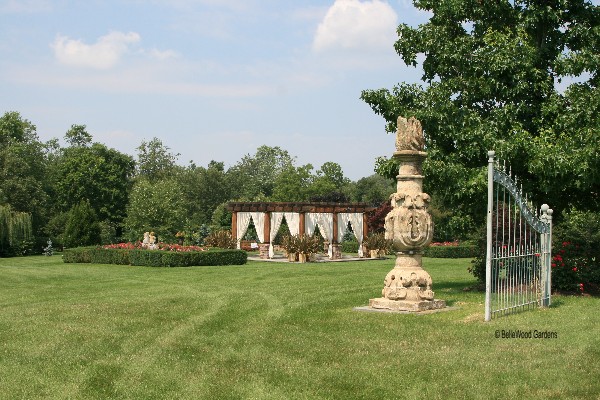
Beyond the house across the rolling greensward
there is much to see: a pavilion draped with lavish curtains,
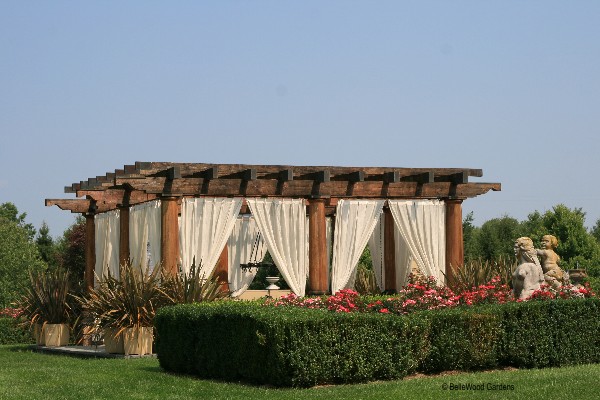
accented with tubs of bronze leaved phormiums

and a rose garden hedged with boxwood and home to a sphinx.

Two graceful gates stand alone, deliniating entry from here to there,
and a pair of massive 17th century European stone torch�res.
The gates direct attention to the alle� of sweet gum,
each tree embellished with roses, in vivid give-me-a-ticket red bloom.
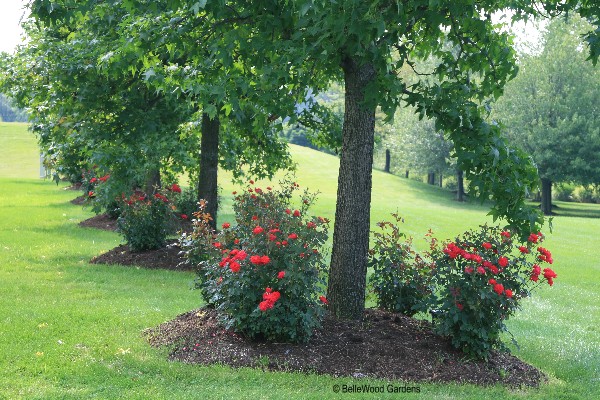

There's a splendid fountain in a small but deep water pool.

A shallow shelf at its perimeter supports lotus, in exquisite bloom.
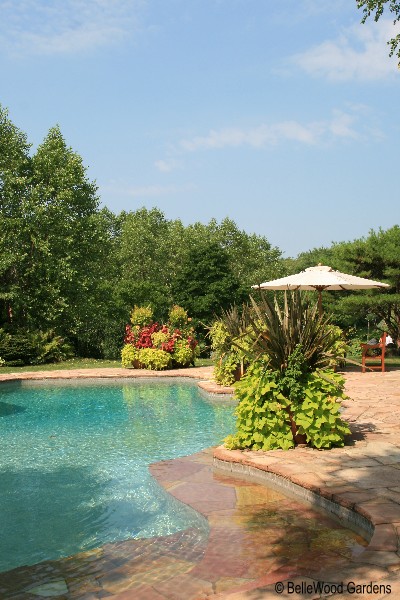
Water is very much a feature of the Twin Silo Farm landscape.
The swimming pool, up near the house, seems more like a pond, with
gently curving form, generous patio, and inviting stepped shelf.

Very inviting, perhaps too much so. Just a splash, not a swim.

There's a lake, obviously discovered by a flotilla of Canada geese.
Another little pavilion tucked in amongst weeping willows on the far shore.
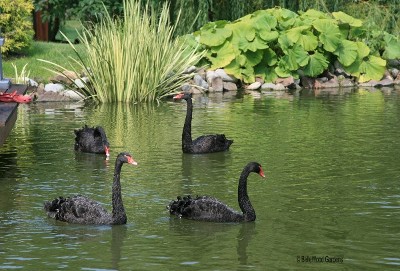
Black swans
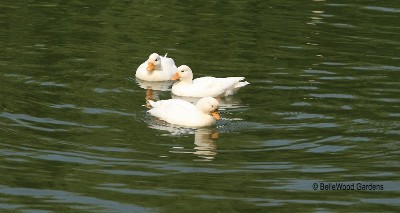
and chubby little white ducks

A pair of substantial gates painted a lively chartreuse green
lead into a walled garden, walled with clipped hedges.
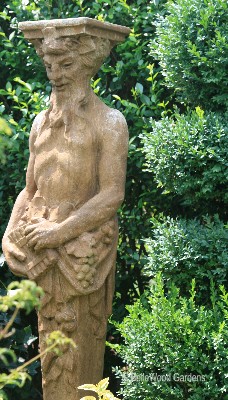
A statue of Pan.
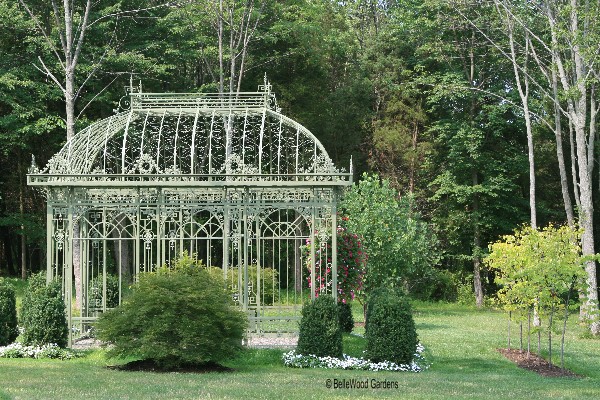
An airy wire gazebo. Can you envision it dusted with snow . . . .
something from a Russian fairy tale, or perhaps the setting for a ballet.
.
Consider taste and money as 2 x 2 contingency table chi-square statistics. Just because someone is wealthy doesn't mean they have good taste. Just because someone has good taste doesn't mean they are rich. Lots of people have no taste and no money. Then there are two smaller groups. One has money but no taste. The other has taste but no money.
Then there are Andrew and Wayne, envisioning Twin Silo Farm as it might be - sweeping spaces, grandeur in design. Collecting unusual species of trees and shrubs, and give them time to mature. Collecting European statuary and artifacts to complement the landscape and its plants. This is a garden that will resonate for decades to come. Taste, and the funding to achieve something extraordinary.
Back to Top
Meadowbrook Farm
The hotel lobby has a small coffee stand / food bar. Bless her, the woman who usually opens it at 6:30 a.m. has been coming early so I can get a caffine fix and a croissant before boarding the bus. Yes, the room has a coffee maker, but only little plastic cups and I don't use those. The coffee just doesn't taste the same. Just as yesterday's first stop at Shortwood, today's will have a continental breakfast at Meadowbrook Farm. This is important as can be deduced when we all queue for coffee, juice, melon and grapes and pineapple, also muffins. Energized, we disperse to explore the grounds of Meadowbrook Farm in Abington, Pennsylvania.
Formerly the home of J. Liddon Pennock and his wife Alice, the property is a lovely sweep of Pennsylvania's gently rolling countryside. Today Meadowbrook Farm (originally 150 acres when the farm, house, and furnishings were given to Liddon and Alice as a wedding gift by her parents) consists of 18 acres of lightly managed second growth woodlands and 7 acres containing the display gardens, garden center, and the private house. Meadowbrook Farm is an affiliate of the Pennsylvania Horticultural Society. The house and gardens may be toured by prior arrangement.
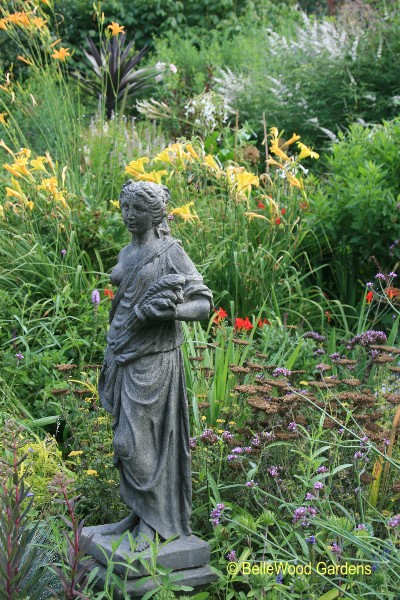
A statue of Pomona, goddess of the harvest, stands in a meadow-like border
with daylilies, crocosmia, Verbena bonariensis and other plants,
welcoming our group as we stroll from parking lot onto the grounds proper.
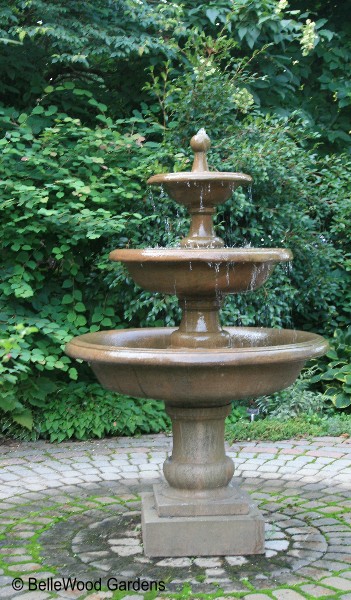
A simple fountain drips and spatters, moistening the moss
that's growing between the paving blocks. It is a focal point as here is where
the path pivots and changes direction, embellished with planted containers.
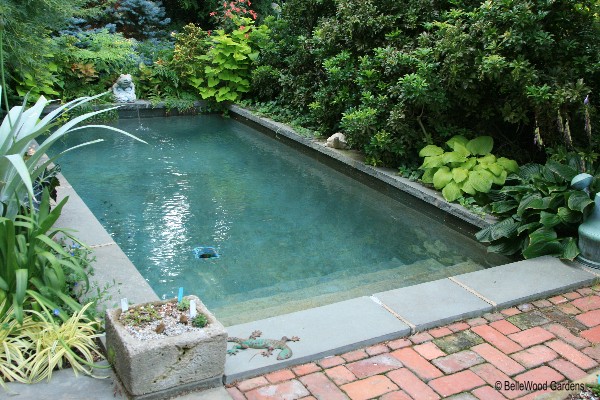
Near the hose is an inviting plunge pool. If I remember correctly,
the story is that Alice felt the swimming pool was too far from the house for
a greet-the-morning dip. So Liddon designed this one for her.
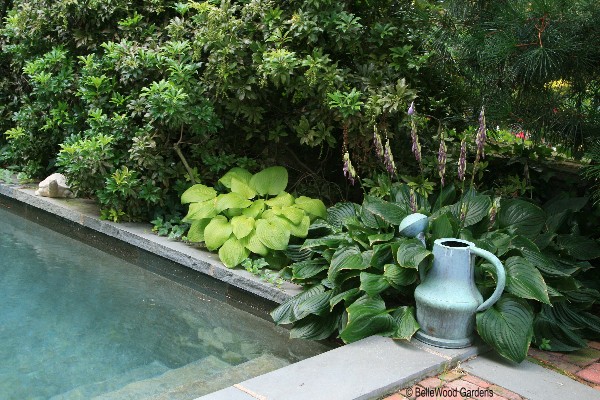
Off at the corner, one of the details that lovingly enhance Meadowbrook Farms.
Along with stones and statues and little lizards, a verdigris watering can
nestles amidst the hostas, its color a perfect complement for the pool.
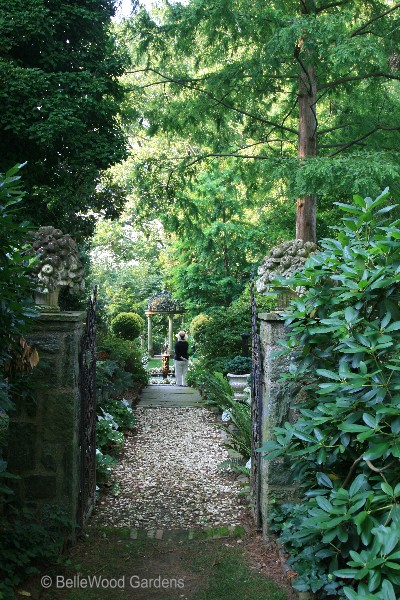
With a designer's eye, the gardens behind the house are strung
along a long axis, each with its own center, and a focal point
to draw the eye and encourage an exploratory stroll.
.
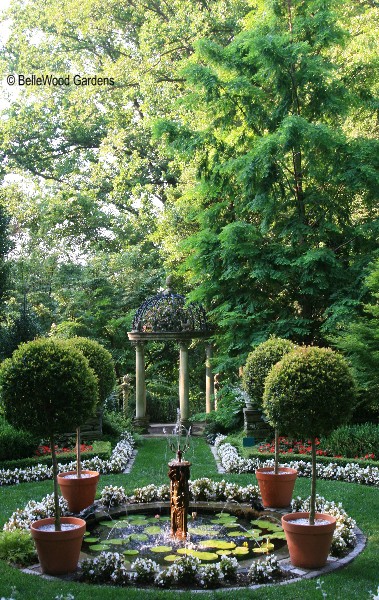
A dainty gazebo crowned with a lacy cap invites the visitor beyond
a small formal lily pool and the geometry of four potted standard shrubs.
.

Pivot around the lily pool and discover the swimming pool,
elegant enough as a feature even without a plunge into the limpid water.
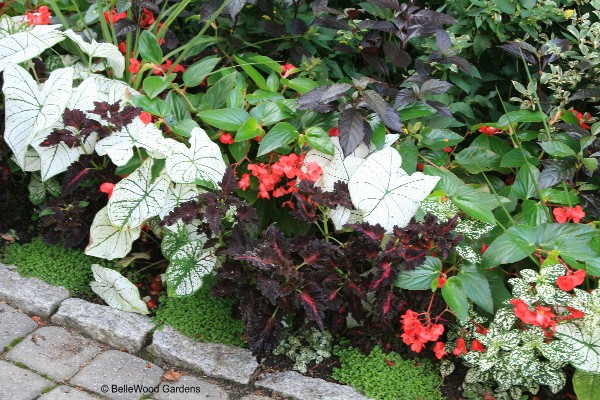
All details are well thought out: here, Caladium 'Candidum'
partners with Hypoestes 'White Splash' at the right, and contrasts with
a marroon coleus, whose central red blotch is matched with a begonia's flowers.
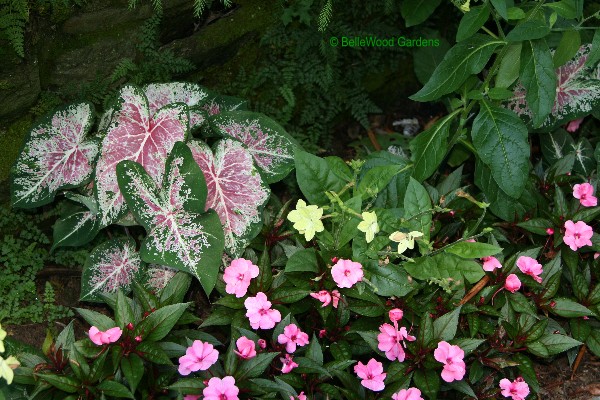
A pink caladium joins with an impatiens.

None of this happens when eleves and fairies come out to play.
Gardens need upkeep, and that takes work. Meadowbrook Farms
has superb staff, and they have the tools they need that keep it looking so fine.
Back to Top
North Creek Nurseries
It's not as if we've been lounging around doing nothing much at all. Load the buses at 6:45 a.m. Off to Shortwood, Stephanie Cohen's garden; off to Waterloo Garden Center; off to Handmade Gardens. Mt. Cuba next, with plants and gardens to see and a luscious lunch to enjoy. Then WynEden, followed by Frog Hollow (I think I have the sequences correctly but if not you can understand, and also why not every last stop got written up) and then we finish at North Creek Nurseries in Landenberg, Pennsylvania.
Founded in 1988 by Dale Hendricks and Steve Castorani, North Creek is a propagation nursery that supplies starter plugs to wholesale and retail nurseries. They offer a large selection of perennials, grasses and ferns with an emphasis on new varieties and Eastern North American natives and their cultivars. The nursery also produces many native plants in larger Superplug / Landscape Plugs� size, that are used in restoration projects and by highway departments, municipalities and conservation societies.
A recent program, American Beauties, a partnership between North Creek Nurseries and Prides Corner Farms in Lebanon, Connecticut, with the goal of promoting native plants and taking the guess work out of gardening with with them. Begun in Spring 2006, American Beauties currently has a focus on the northeastern United States. Since each region of the country has its own native plants, the eventual goal of the partnership is to grow and distribute American Beauties plants on a regional basis throughout the United States. At the same time, they are helping to promote the message of the National Wildlife Federation while doing so.
Arriving at the nursery we piled off the bus. We were plied with wine and beer,
shown a place where we could stash backpacks and belongings,
and turned loose to wander around and enjoy ourselves.

There are several trial and demonstration gardens. These folks, drinks in hand,
are perusing what's growing in the upper trial garden where plants such as
.
Phlox Mary Jane 
.
and Solidago Sweety 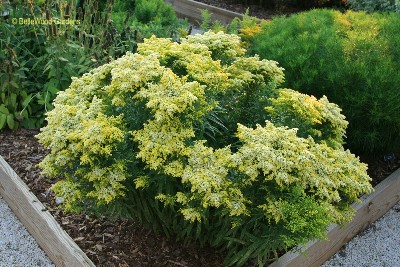 are in bloom.
are in bloom.
There are other display gardens with a functional theme, such as this rain garden.

Plants that thrive with intermittent runoff are planted in a swale where
they can soak up storm water, reducing flooding and recharging ground water.
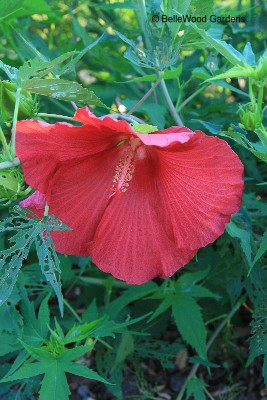
And, like this hibiscus, they're lovely as well as functional.
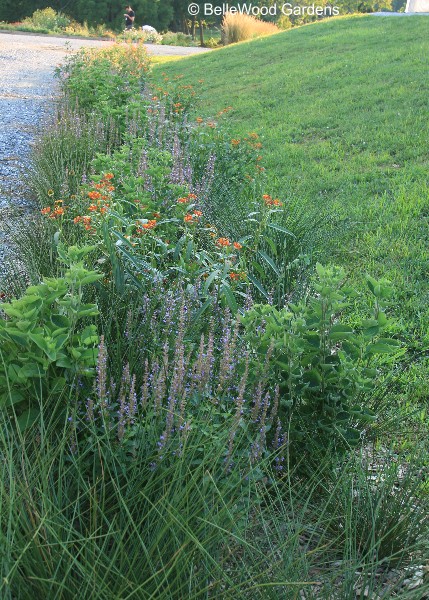
A bioswale serves much the same purpose at the toe of a slope.

Word gets passed around that food is ready, and we head off to the party tent
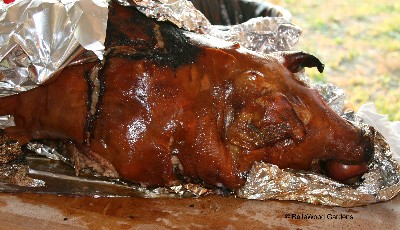
where a succulent roast pig, various side dishes, vegetables and rolls
and more drinks await us. Just a casual Friday night get-together with a few friends.
But why does Dale have such a merry "I've got a secret" grin on his face?

.
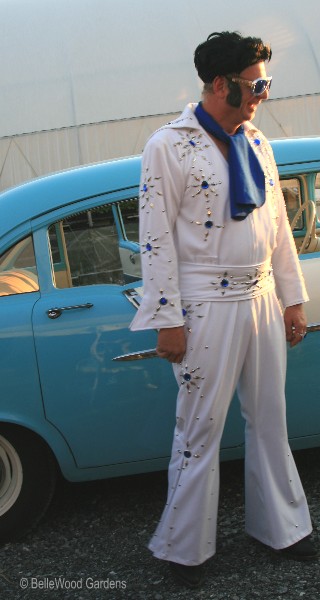
Oh my god! It's Elvis! Elvis lives!
And he's come to party with us. Didn't know he was
that much into plants and garden though, did you?

John, Ron, and Elvis
.
What a truly fabulous day. But can you understand why I took the early bus, getting back to the hotel sometime after 9:00 p.m. Unquestionably, today has been fantastic. But there's things to do before I sleep: images to offload from camera card to laptop, a shower is definitely required . . . . and tomorrow starts with another bus pulling way from the hotel at 6:45 a.m. Let's see if it can top this one - or even just match it.
Back to Top
Echinacea Trials at Mt. Cuba
When Mrs. Lamont DuPont Copeland was alive, this space was used for the cutting garden. Perennials, annuals, bulbs - plants grown for bouquets to adorn the house whenever she was at home. After she died in 2001 the property was taken over, as planned, by the Mt. Cuba Center, Inc. a private charitable foundation. The cutting garden became a trial garden, assessing the merits (or lack thereof) of various plants. The current trial is of prairie conflower, Echinacea species and cultivars.
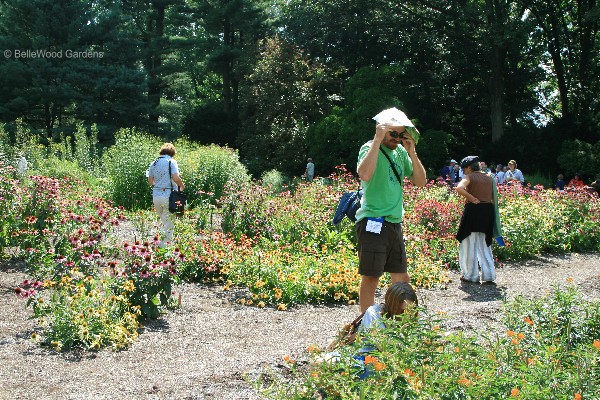
The program is breeding for floral display; flower color; flower size; quantity of bloom; and blooming period. As well, plants are assessed for their habit: height and width; quality of foliage; need, if any, for staking; winter hardiness; cultural adaptability; disease and pest resistance.
Prairie coneflower, Echinacea purpurea, is a native herbaceous perennial that is popularly grown in the flower border and naturalistic meadow-style designs. Butterflies nectar on the flowers, and - if spent flowers are not removed, allowing seeds to form - prairie coneflower also provides winter food for small birds such as goldfinches. Fresh, the flowers make a good cut flower for bouquets, while the thistle-y centers of dried flowers may be used for winter arrangements. Two common issues: petals tend to droop, and it would be nice if there were more options than the flowers' typical crushed raspberry pink petals and orange center.
There are other species. E. paradoxa, unlike all the others, has yellow petals and is important in several breeding programs.
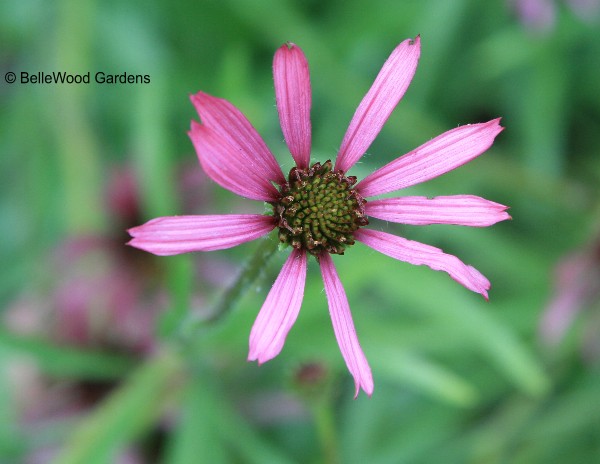
E. tennesseensis is a southeastern native only known to naturally occur
on certain glades near Nashville, Tennessee, and it is on the Federal Endangered Species List.
Flowers appear from early June until August, and have dark mauve, somewhat upturned petals
and a greenish tint to their coppery pink centers. Compared to the more familiar E. purpurea,
the Tennessee coneflower is somewhat less vigorous and smaller.

'Rocky Top' is a seed-raised cultivar of Tennessee coneflower, with numerous pastel pink,
flat-topped flowers on compact, vigorous plants. It is a particularly good choice for hot dry sites
where other species fail to thrive. Compact, 'Rocky Top' typically grows a compact 2- to 2 1/2-feet tall,
with 2- to 3-inch diameter flowers having upward-turned pink petals and dark central cones.
Flowers appear from June to August with some sporadic later bloom.
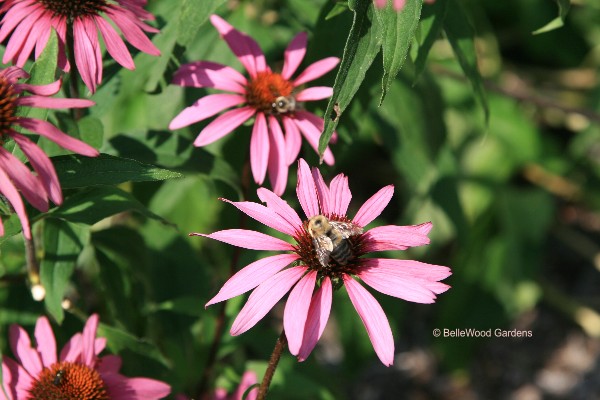
Smooth purple coneflower, E. laevigata is also a federally listed endangered plant,
found in the piedmont of the southeastern United States. Though historically reported from Pennsylvania
and Maryland, its current range appears to be Virginia, North Carolina, South Carolina, and Georgia.
Echinacea cultivars on trial at Mt. Cuba:
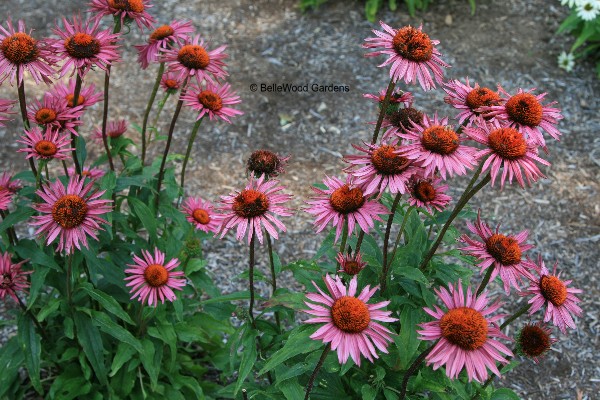
A dwarf purple coneflower that grows only 16 inches tall, 'Little Giant'
still produces large flowers. It was discovered in a planting of E. purpurea 'Ruby Giant'
and is distinguished by much shorter plant height, longer and narrower leaves, and
huge, 5-inch diameter, deeper red-purple flowers with an interesting fragrance.
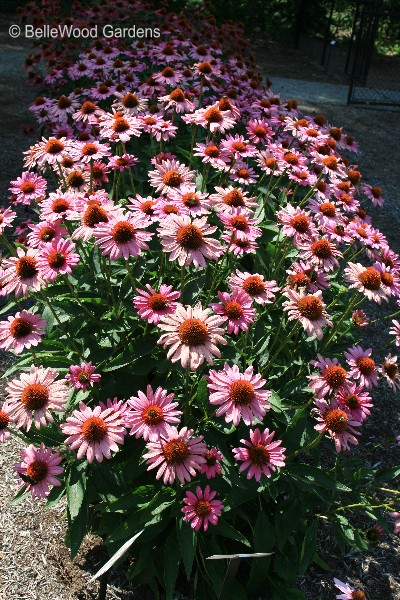
'Elton Knight' is a selection from the UK, made by Anthony Brooks, gardener at Elton Hall
and named for Thomas Andrew Knight, a founding member of the Royal Horticultural Society.
It is one of only three coneflowers to receive the prestigious Award of Garden Merit in the 2003
Royal Horticultural Society's Echinacea trials, selected for its sturdy 2 foot tall compact habit
and great branching. Summer flowering, the 5-inch wide flowers have outwardly held petals.

'Pica Bella' is a compact purple coneflower typically growing in an upright clump
to 2 feet tall, occasionally higher. Narrow, deep pink rays and orange-bronze central cones
appear from June to early September, sometimes with sporadic later bloom.
The Royal Horticultural Society's Horticultural Database reports that 'Pica Bella'
is a seedling of E. purpurea 'Abenstem'.

'Vintage Wine' is a chance seedling of two unidentified selections of E. purpurea
that is notable for its upright habit, long bloom period, and horizontally held red-purple petals
and dark red-tipped disc. The flowers also have a sweet but faint aroma.
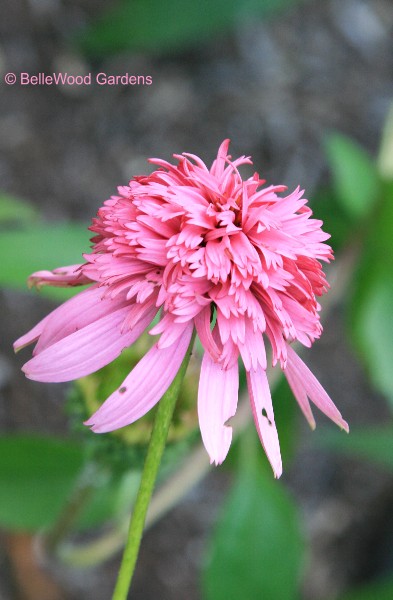
The very first time I saw this double-flowered version of a cone flower was at the Floriade
in Holland, in 2002. 'Razzmatazz' had been discovered as a sport among seedling coneflowers by
Jan van Winsen, a specialist in annuals and cut flowers. He began cropping it by 1997 but 5 years later
it was still not marketable as cut flowers. The rose pink, anemone type, double flowers are a hit
in the garden, where flowers bloom from mid-summer to fall atop rigid stems 24- to 30-inches tall.
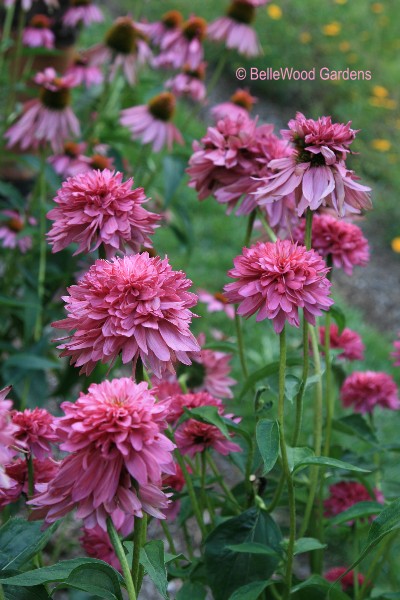
Other double echinacea are appearing in the trade. Also sold as 'Doppleganger',
'Doubledecker' has bright pink petals that droop from beneath the large bronze cone,
and a smaller, irregular bloom sprouts atop the mature, round seed head.
'Doubledecker' was discovered by German plant breeder Eugen Schleipfer.

'Pink Double Delight' is shorter than either 'Razzmatazz' or 'Doubledecker'.
Developed by Arie Blom of the Netherlands, each flower is composed of
an oversized, dark pink cone adorned with lighter pink petals. Flowers begin
to appear in July, and continue until frost, with double flowers from the start.
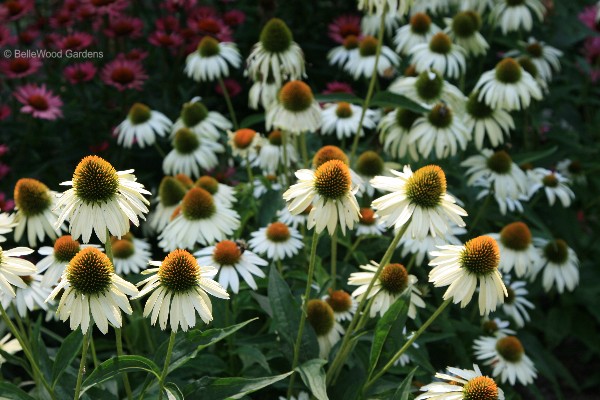
One of the older white-flowered cultivars, 'White Swan' is not as cold hearty or vigorous
as its typically rosy pink progenitor, nor as vigorous or floriferous. What it does have going for it
are 3-foot tall stems surmounted by flowers with lovely white petals surrounding a brown disc.
Flowers appear from late June to late July, with some sporadic flowers continuing into September.
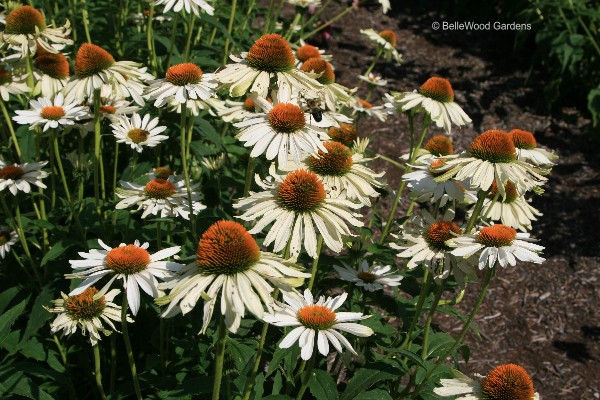
'Fragrant Angel', the white counterpart of 'Ruby Giant', has 4- to 5-inch diameter flowers,
pure white petals around a contrasting orange cone, and is described as "deliciously fragrant."
It is said by Terra Nova Nurseries to be "the best white coneflower that we have ever grown."
Clonally reproduced rather than seed raised, each plant is identical for a more uniform planting.
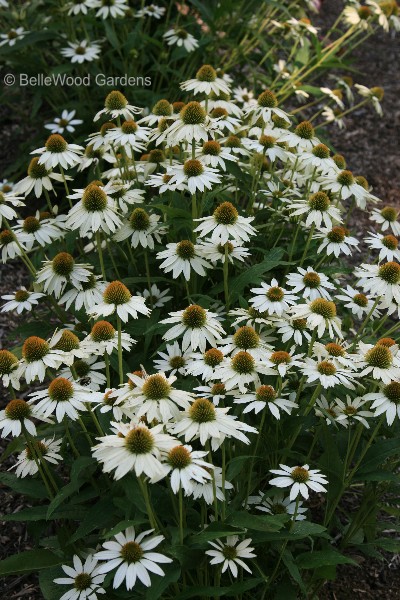
'Kim�s Mop Head' is a white flowered version of E. purpurea 'Kim�s Knee High'.
Only 13- to 16-inches tall, it is noted for its short and compact size and
drooping pure white petals with greenish tinged center cones.
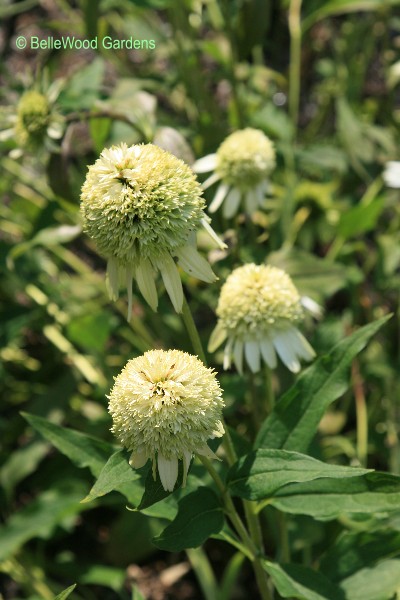
'Coconut Lime' is reportedly the first double white coneflower to be introduced into commerce
Also from Arie Blom, in IJsselstein, the Netherlands in 2004, it is the result of an open pollination
of unnamed E. purpurea parents. It typically grows in a clump to 24- to 30-inches tall
with sturdy stems that do not need staking. Drooping white to yellow-green petals
are notched at the tip, with a globular, pompon-like lime green center cone.
Flowers from late spring to late summer, with additional sporadic bloom until frost.
When experimental crosses between Echinacea purpurea and E. paradoxa began producing offspring with orange, gold, and mango-hued flowers these new introductions were hotly desired, in short supply, and very expensive. Richard Saul of Itsaul Plants in Atlanta, Georgia, is one of the plant breeders in the vanguard of what he calls the "cone craze." His claim to fame is the long-blooming Big Sky� series.
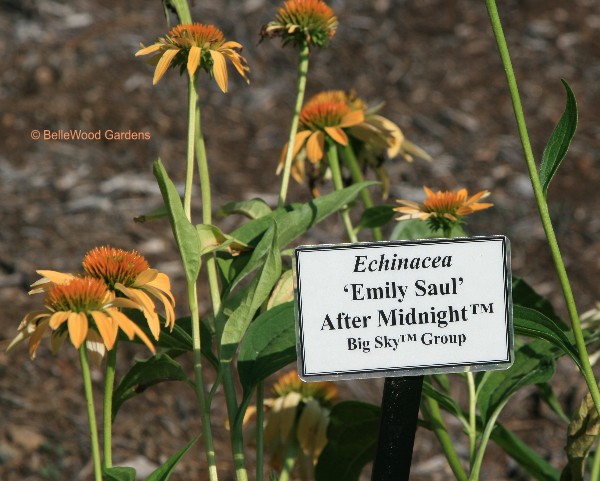
Great plant, but I think it is incorrectly labeled. 'Emily Saul'
Echinacea Big Sky� After Midnight is described as having
dark magenta petals with a black-red cone and dark stems.
Looking at the Itsaul website, I think what we see here is
'Mathew Saul', Big Sky� Harvest Moon. By whatever name,
it is gorgeous. Need the name to acquire the coveted plant.

Mt. Cuba is performing an invaluable service for gardeners, growing and comparing
such a tremendous diversity of echinacea. I'm looking forward to their report on the results.
Back to Top
Mt. Cuba
The DuPont family and their gardens are integral with the Delaware Valley region. There's Longwood Gardens and Winterthur, and Mt. Cuba. Longwood offers its visitors formal gardens, a marvelous conservatory, an elaborate fountain display, and more, all on an elaborate scale. (The outdoor gardens cover about a mile, with an estimated walking time of an hour and a half.) Winterthur, though noted for its premier collection of antique furniture and furnishings, is also well-renown for its gardens. The March Walk, for example, is a fantasy carpet of bulbs - scilla, chionodoxa, spring snowflake, eranthis, and early little daffodils - beneath towering beech trees. Mt. Cuba, in Greenville, Delaware, is different.
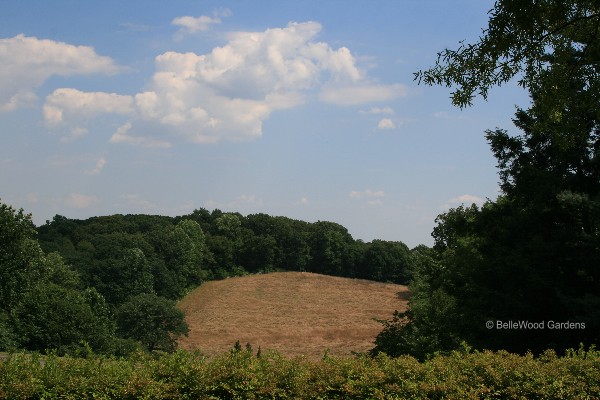
A view from the terrace, over rolling countryside, hayfield, and forest.
When the Copelands bought the property in 1935 it was a bare corn field. No trees.
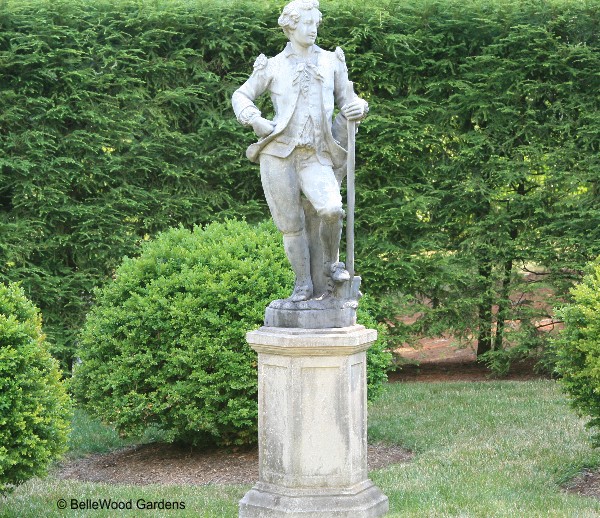
A house was build. Thomas Sears designed the formal gardens around it.
Hedges created garden rooms. Statuary embellished it.
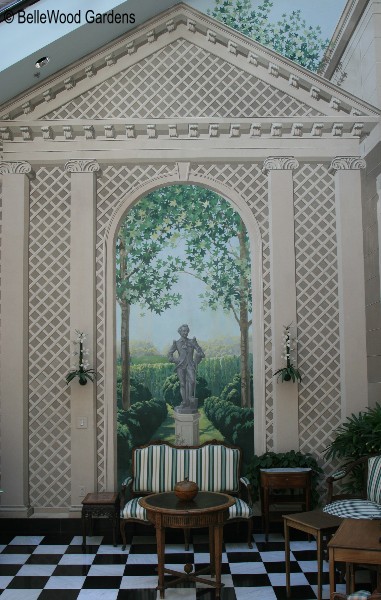
A wonderful piece of trompe l'oeil painting in the conservatory.
Even the latticework is an illusion, its three dimensional appearance
created with paint flat on the wall,and the columns, and also the statue.
We had our buffet lunch at Mt. Cuba, and while others dined outdoors
on the terrace I and a few others opted for the elegance of the conservatory.
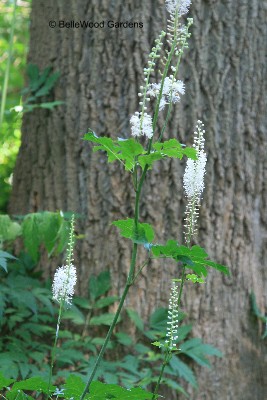
In the 1950s Marion Coffin, a noted landscape designer, signed on
to expand the Copelands' efforts. Tulip poplars, some saplings moved
from nearby fields around 1938 grew and created a forest canopy. By the 1960s
the Copelands attention grew focused upon Delaware's native flora, and then
that of the Piedmont region. Here, bugbane, Actaea americana, displays its white candles
against the towering columnar trunks of a tulip poplar, Liriodendron tulipifera.

Maryland pinkroot, Spigelia marilandica, jauntily displays its attractive
two-tone flowers. It's one of our few summer-blooming, shade-tolerant native plants.
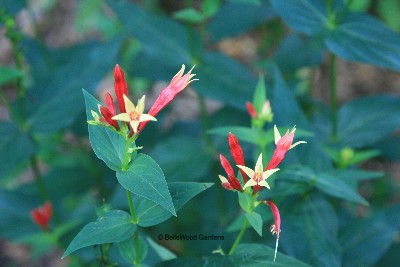
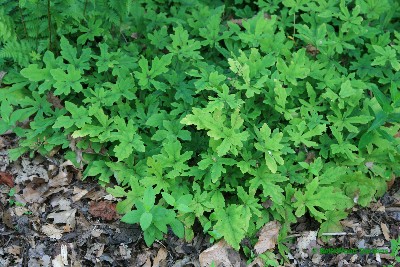
Generally, by late July the woodland garden must rely on foliage. Here,
the attractive lobed leaves of Tiarella make a patterned carpet along the Woods Path.

Canada ginger, Asarum canadense, offers bolder foliage, like an ace of spades.
Paired with barren strawberry, Waldsteinia fragrarioides it looks even better.
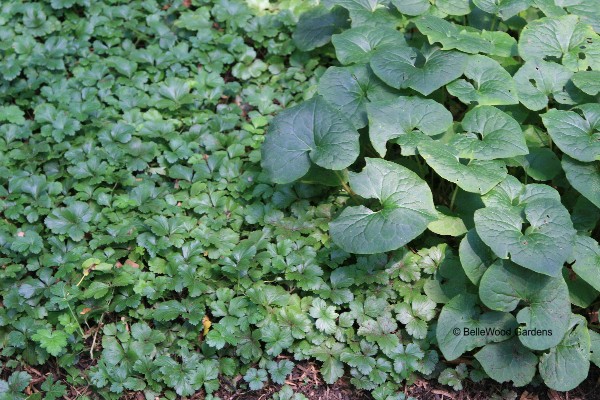

Taxonomically revised from Asarum to Hexastylis, this attractive little evergreen plant
is now weighted down as Hexastylis minor'Dixie Darling'. Whatever the name appended to it,
glossy, silver laced evergreen leaves would make it welcome in my - or most any other shady garden
Back to Top
Frog Hollow
Fun and games in a garden. Frog Hollow, the garden of Eve and Per Thyrum in Wilmington, Delaware, is 25 years old, and everywhere you turn on the 2 1/2 acres there is something else to admire. Lovely flowers. Woodland retreats. Imaginative, whimsical, elegant art. A pond. And on this visit, I kept finding bubbles.
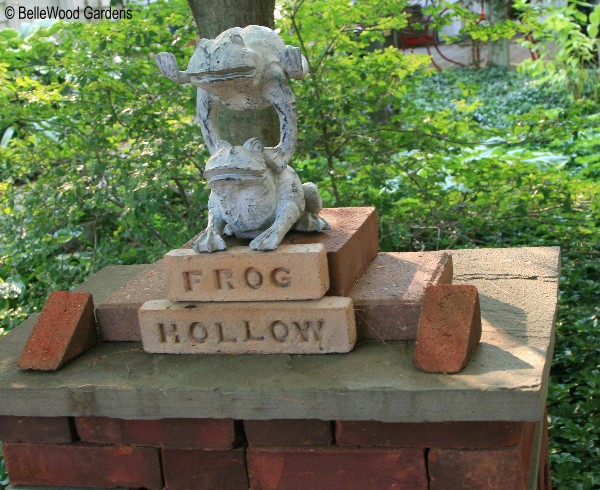
Leap, frog, and welcome to Eve and Per's Frog Hollow garden.

Inviting seating under the sheltering branches of a huge tree, with a silhouette -
of a chameleon, perhaps? clambering off on a branch massive enough
to serve as a tree in another garden. Not just a chair for one, or for two, but sufficient
for husband and wife and friends to enjoy a peaceful moment in the garden.
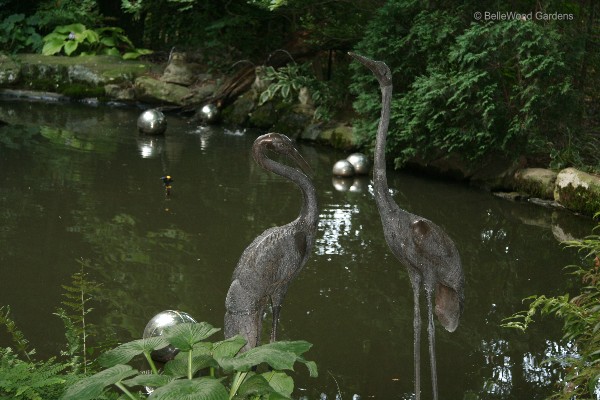
A pond and garden house at the back of the property. Two cranes
(or perhaps they are herons) and some silvery bubbles floating
in a couple of different sizes, serenely floating, on the water's mirror surface.
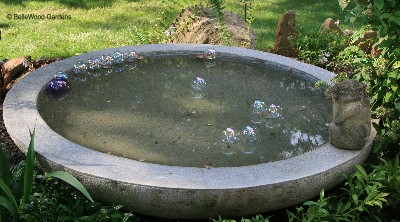
By the driveway and in front of the house, a huge, shallow, granite bowl
with bubbles as ethereal as if truly just a fragile film of soap. So light,
the wind directs them off to one side. I rearranged some to improve the image.
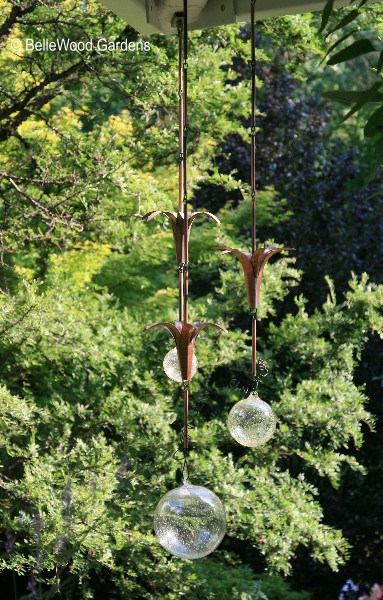
Copper flowers, hanging from the eaves. I think they're segments
of a rain chain. Embellished with - what else but bubbles.
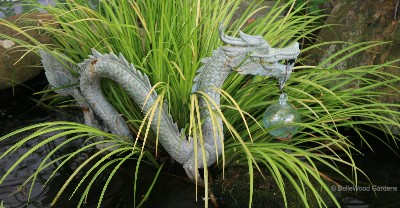
Even this little dragon, sinuously weaving
in and out of a sedge clump, carries a bubble in his mouth.
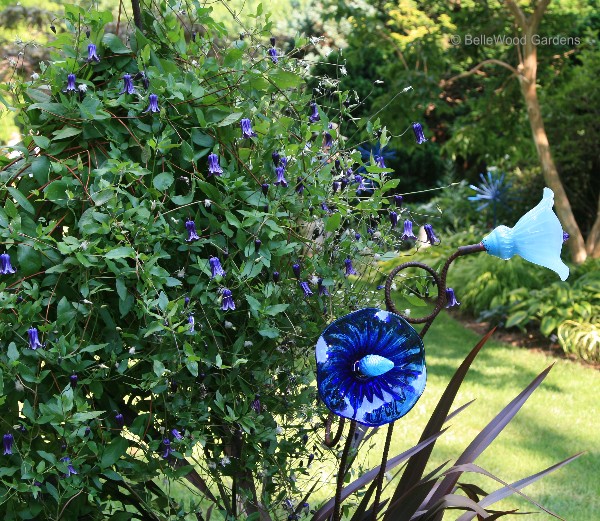
An artist's eye for combination. The dainty blue flowers of Clematis alpina,
create a background that makes up in numbers what they lack in size
for two huge glass flowers that share but alternate the arrangement
of their shades of blue, and whose rusty rebar stems match
the sword-like, dusky bronzeleaves of phormium.

And graciously, mine host refills the antique dispenser with a delicious brew,
a blend of mint and tea and cranberry juice. Much appreciated by the thirsty busloads
of garden visitors. The wing-like roof shelters an outdoor seating area
on the patio. Quite close to the house but a welcome destination from which
to admire the island beds and perimeter delights of the Frog Hollow gardens.
Back to Top
WynEden
Any garden tour in the Philadelphia / Delaware Valley area must visit Longwood Gardens, must visit Chanticleer. It's a given. Both are wonderful, and a delight each and every time I'm there. But when a group such as Perennial Plant Association visits an area, symposium participants get to visit private gardens that would otherwise be unknown to them. The post-conference tours are generally best for this. It is difficult to find someone willing to allow the full complement, 700 strong, to tromp through their garden, crowd around the flower beds, and beat the lawn into bare dirt. A post-conference contingent of a mere four bus-loads is another story. So it was when we visited WynEden, Doris and Wayne Guymon's garden in Chadds Ford, Pennsylvania on Friday, 25th July.
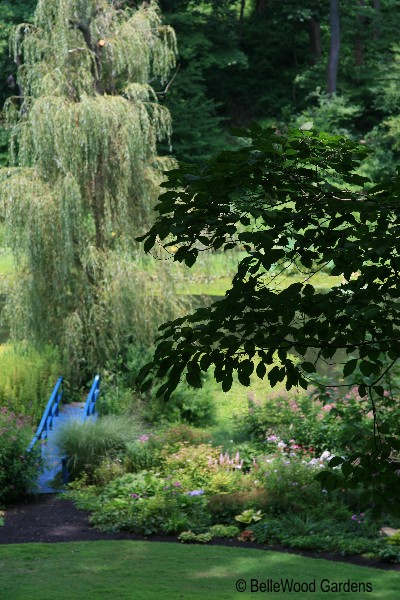
In the years since Wayne and Doris bought a weekend house in Chester County
the 6 1/2 acres of hillside jungle and overgrown, weed-ringed pond have been transformed
into a woodland sanctuary. The one acre pond is home to water lilies and lotus, and a simple bridge
leads onto a small island that is home to a graceful weeping willow while flower beds skirt the shore.

As you can see we got distracted just walking down the spacious side path through the woods.
It is ample enough for a quad and other equipment, planted attractively enough to capture the attention
of people walking at a slow stroll whilst admiring hostas and a diversity of their companion plants.
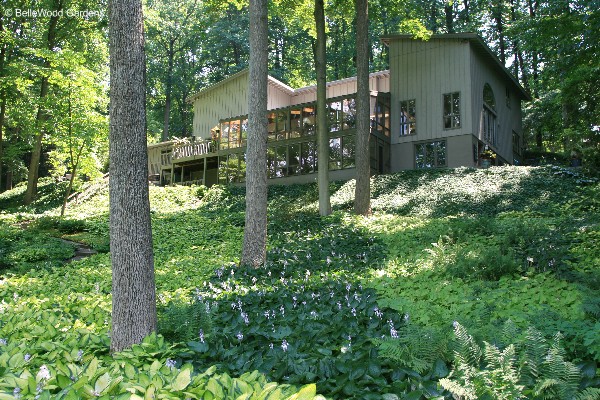
The hillside sweeping down from the house is a mass of hosta, planted in undulating streams,
broad bands of different cultivars. Every white tail deer's wet dream of a garden qua salad bar.
But there's a fence.

There are other embellishments than plants. At the front of the house, an Indonesian dancer,
flexible, lichen-coated limbs artistically contorted, and flowers tucked between headress and ear.
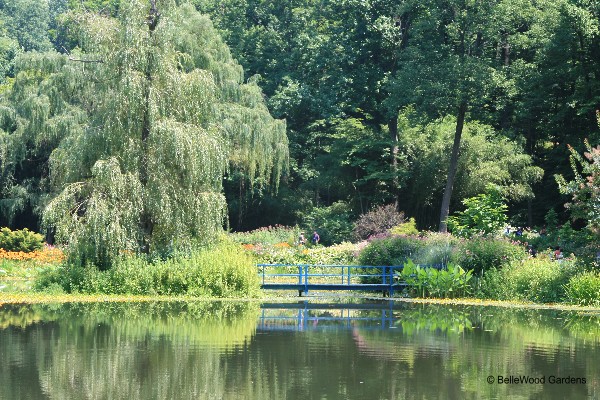
An easy grassed path, more of a raised berm at the rear of the pond, invites the vistor to take
a stroll around the pond and enjoy the ever-changing viewpoint that delights the eye.
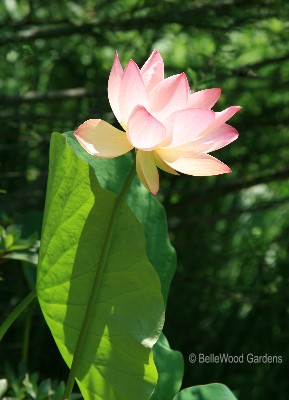
Here, a lotus in bloom.
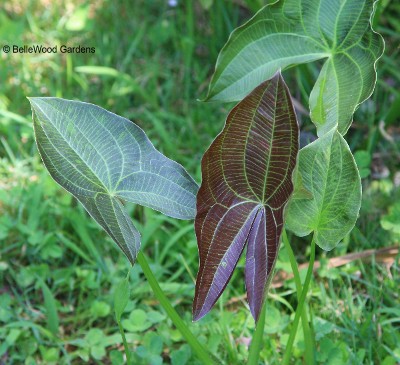
There, Sagittaria australis Silk Stockings�, with deep bronze new growth.

Overhung with bamboo, a small feeder pond spills into the larger one. A little footbridge
invites people to step out amongst the iris leaves to look for golden fish darting in the water.
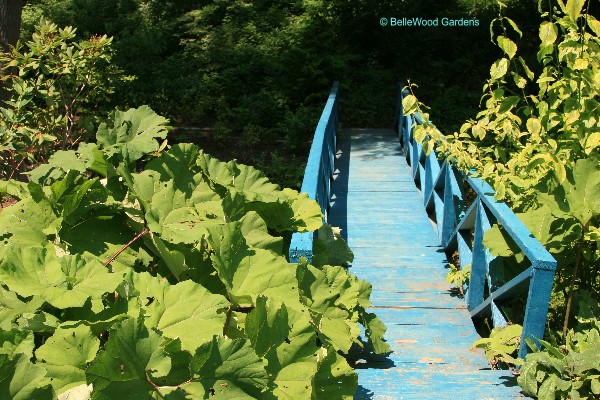
A weathered bridge leads yet further, beyond the pond
and into the highly edited woodland of the northern hillside.
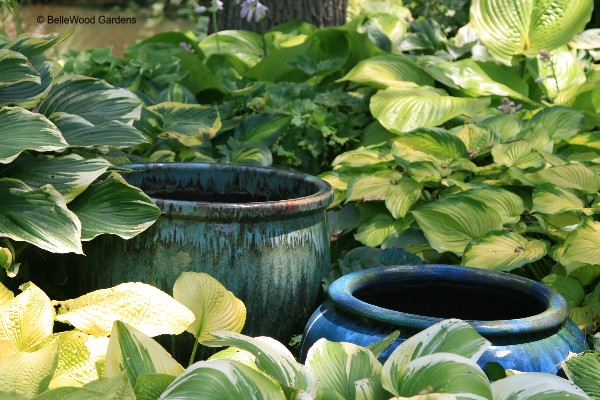
Two graciously proportioned pots, the verdigris and turquoise of their glazing a fit compliment
to the diversity of hostas that embrace them. Elegant as hollow forms, no need to fill with soil, and plants.
Back to Top
Handmade Gardens
Friday, 25th July 2008 was available as a post-conference optional tour. There were two tours, each with a different focus. I chose the estate gardens of the western suburbs. Of course, to put us in the mood, early in the outing we stopped at a couple of garden centers. The one that captured our attention was Handmade Gardens at 320 West Uwchlan Avenue in Downington, Pennsylvania. What a fun place!
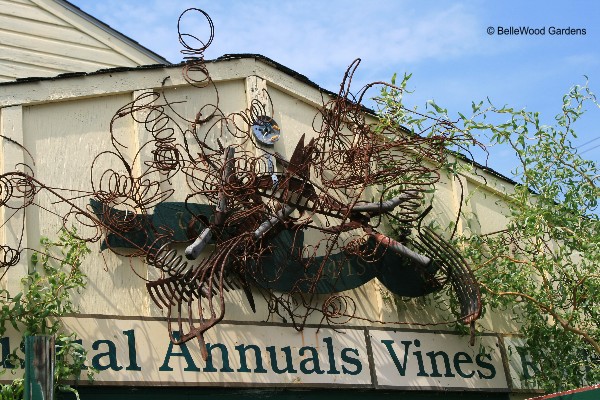
As the exploding ironmongery suggests, objects trouv�s are a hallmark of Handmade Gardens.
So who started this eclectic place for gardeners hoping for good design, fascinating plants, and a unique take on garden design? Michael Petrie is a garden designer and best-in-show winner at the prestigious Philadelphia Flower Show. He and Sue Phillips, a Pennsylvania certified horticulturist, were long-time employees of the J. Franklin Styer nurseries and Rose Valley nurseries. Styer's, alas, is no more, having been taken over by Urban Outfitters and renamed Terrain at Styer's. So just this past March Michael and Sue opened Handmade Gardens, offering interesting and unusual annuals, perennials, other nursery stock and objects trouv�s (that's found art, for us hoi polloi), antiques, and more.

Presented with a couple of busloads of enthusiastic garden folk, Michael still manages a charming smile.

The effects may seem casual, but this clean and organized work area shows a disciplined work ethic.
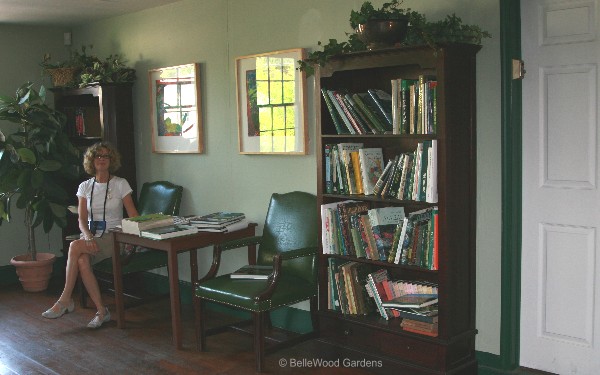
Here's my roommate Alison,in the library upstairs from the shop. What a pleasant place to check facts
and details about plants and more. When I told my daughter that Alison and I were going to be sharing a room,
Mira assumed we were already friends. Perhaps not before, since we didn't know each other,
but yes, after the conference. She was very good at retrieving my name tag that I habitually left in our room.
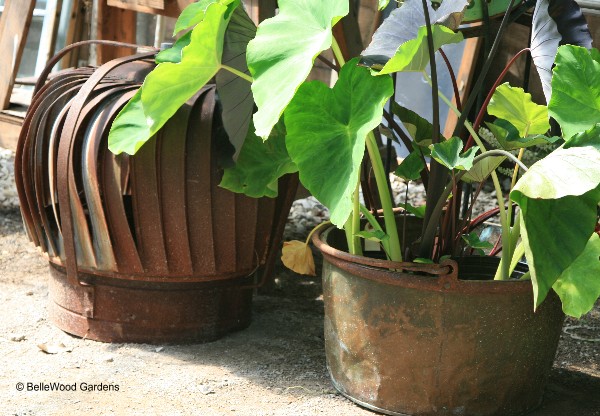
So the nursery has seemingly casual combinations of plants and "stuff", like
a large pot full of elephant ear and a rusty old barn ventilator. Looking good together, don't they just.
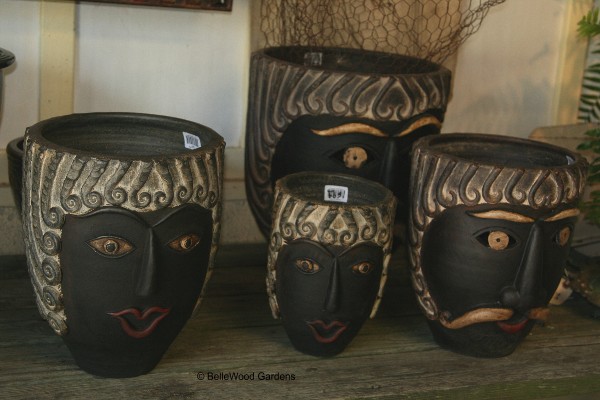
Then I found these funky new pots, modestly priced. And I got into the spirit of things.

I tried one pot out with a yellow phormium. Not bad, but not great.
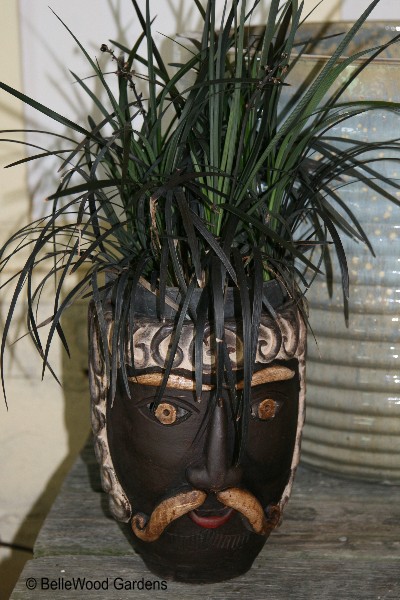
Maybe black mondo grass, Ophiopogon planiscapus 'Nigrescens'. Definitely better, but . . . .
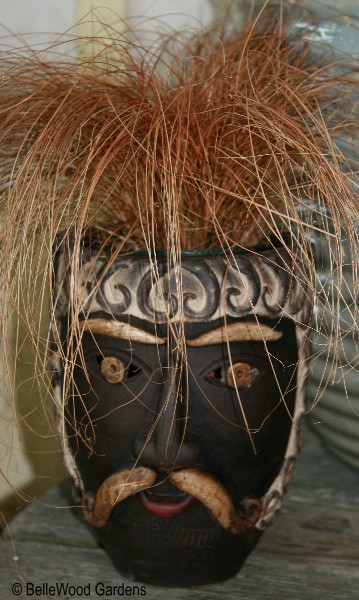
Yes! Carex 'Bronzita' is it! So I bought a pot, and a plant, and I'm happy.
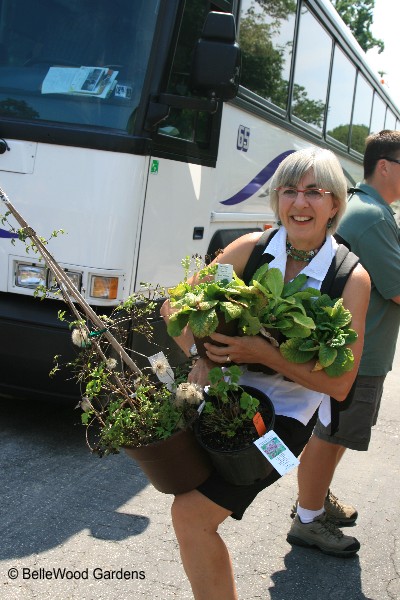
But perhaps not as happy a camper as this tour participant. I do hope she was, like me,
driving home at conference end. Airlines are getting so persnickety.
Back to Top
Mystical, Magical Bus Tour
"Simple rented a bus," was the word going around. "We'll go to Michael Bowen's first, and then Simple's, after dark, so we can see the neon." Now, there have always been after-hour forays as part of the Perennial Plant Association annual symposiums. There have even been car pooling efforts, and multiple car caravans. But I don't think there was ever something as grand(iouse) as a bus. And I'm not talking about no little 10-passenger mini-van kind of bus either. Nope. This was the same size 45-passenger, restroom in the rear bus that we'd be on for our symposium tours. Heck, the price was right, the people are fun, and the two locations we'd be visiting . . . . well, let's just say I had my money in my hand and was ready to climb aboard. There was beer, there was wine, there were snacks, and there was us, ready for the mystical, magical bus tour.
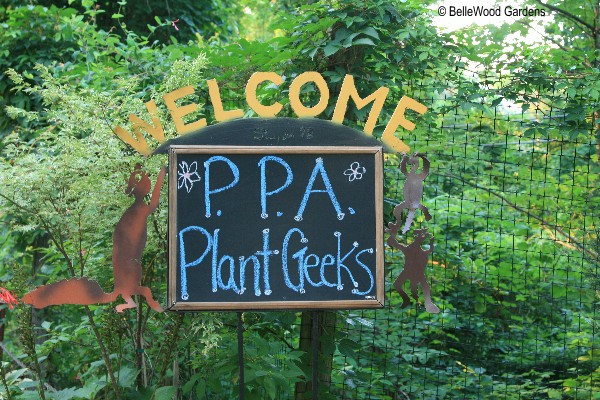
Michael had a welcome sign out for us.
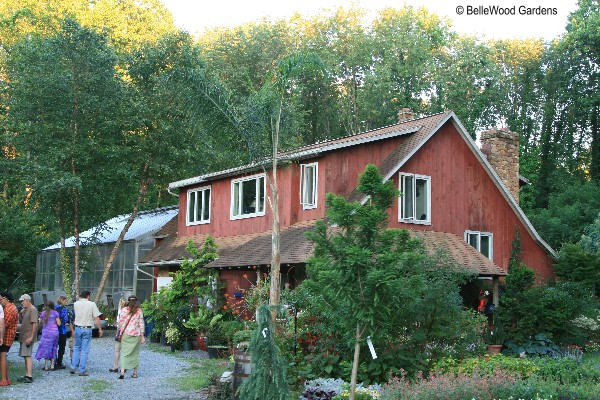
I first visited here many, many years ago. How many? Let's put it this way,
Michael had the greenhouse up and operating, but the house was not yet built.
Priorities, need your priorities. The plants were well housed and he had a trailer.

Such a nice smile. Such a nice guy. What a great party.
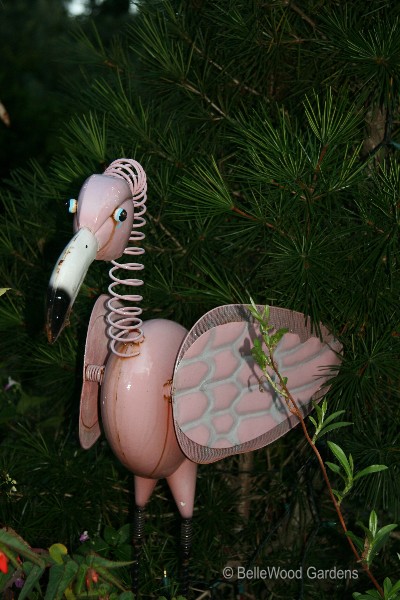
There are secret garden rooms nestled behind trees and shrubs, little paths,
a pond, arbors and gazebos. And "stuff", like this flirtatious flamingo.
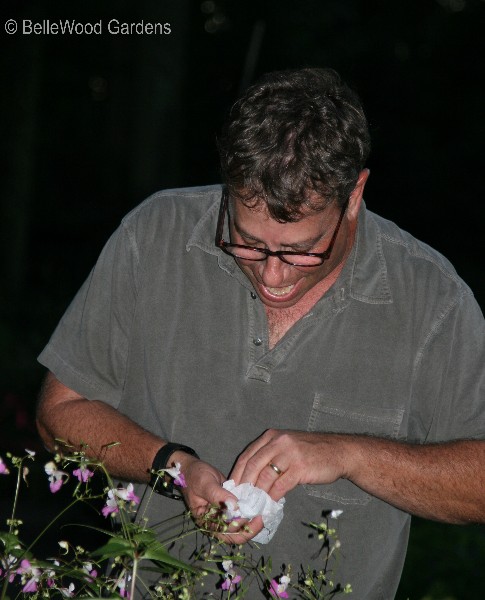
Plant geeks indeed, seed thief, more like it. But hey, Impatiens balfourei,
the Himalayan impatiens, makes lots of seed. It's an annual. But surely, couldn't this guy
come up with something better than a tissue in which to collect the seed?
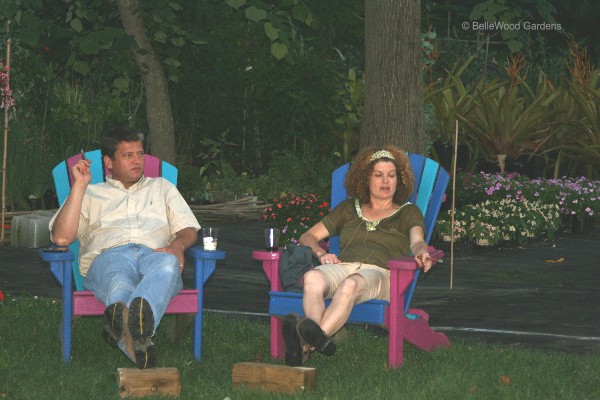
Oh well. Georg Uebelhart and his co-worker Mary Vaananen found a couple of chairs
and settled down for a relaxing smoke. Cigarillos. What did you think I meant?
They're both at Jelitto, an excellent wholesale source for perennial seeds.

Photograph Credit Rita Randolph, all rights reserved.
Now it is dark out. We're back on the bus and on our way. Here's Simple with his electrifying
neon jacket. See the little green and blue lines on his sweater? They're neon tubes, tiny little,
apparently flexible, battery-connected, light up and glow in the dark neon tubes. Is that not like, too cool!
And thanks to Rita Randolph, who graciously allowed me to post this image, so much better than mine.
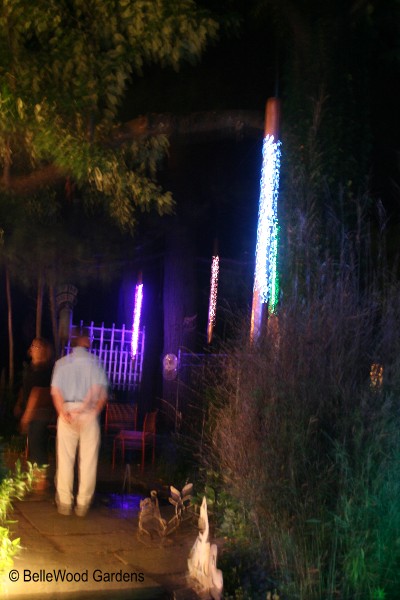
But not as cool as Simple's garden. Showers and spears of utterly cool light
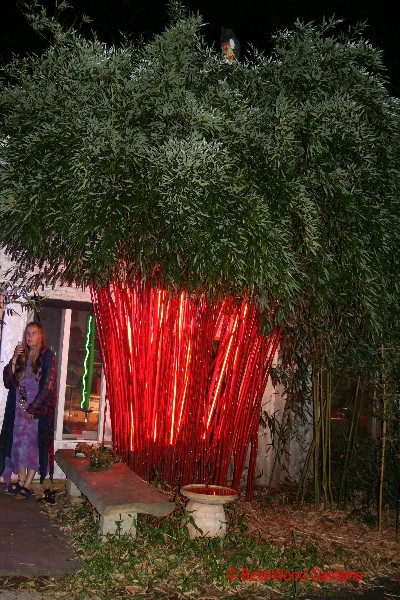
a grove of bamboo with wands of red neon intermixed with the culms

and music, lovely music. Samuel with his fiddle. Charolett and her auto-harp. Dan Heims
(maybe you know him as the fascinated with variegations proprietor of Terra Nova Nurseries)
on harmonica, along with Dale Hendrick's son on another. Simple built this room, a living yurt of sycamore saplings,
the brick floor embellished with a marble compass rose. A small pool in the middle, water bubbling through a millstone,
and a flickering flame from a gas jet in the center of that. What a fantastic evening on the mystical, magical bus tour.
Back to Top
Water Plants at Longwood Gardens
Longwood Gardens is renown for its gardens: formal topiary, the flower garden walk and idea gardens filled with exquisite flowers. There are majestic trees, opulent architecture, fabulous fountains, and the marvelous conservatory with a fern passage, a banana house, a patio of oranges, and an orchid house, and more. They even have a lawn, under glass, large enough to mow. Stupendous in many regards, I am especially fond of the outdoor water lily display courtyard, which nestles between the conservatory's wings.
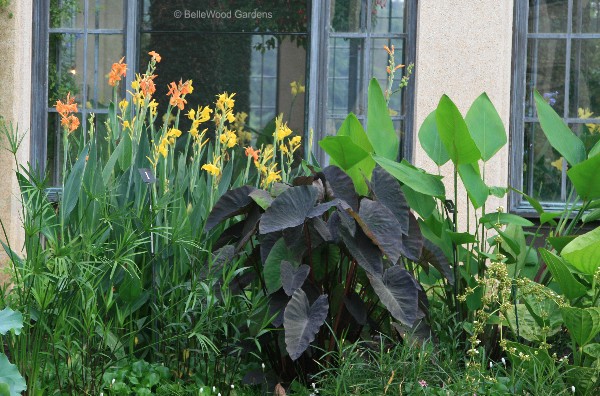
Water lilies and lotus are true aquatics, obligate water plants that only grow in water, albeit shallow,
over their roots. Other plants are facultative wetland plants, with the ability to grow in wet to soggy soil,
some, even in shallow water. Cannas all thrive in damp mucky soil, and one species, Canna glauca,
a native of South America, is noted for its ability to grow well in shallow water. As the name suggests, it has
glaucous, bluish green leaves. The flowers are small and pale yellow. In the 1970s, Longwood Gardens crossed
C. glauca with several different terrestrial cannas, producing the four hybrid water cannas. Seen here are
'Tanny', with burnt orange flowers, and yellow flowered 'Ra'. The other two are 'Endeavor', which has red flowers,
and 'Erubus', which has salmon pink flowers, and . These Longwood cannas typically bloom all summer.
Growing in the same bed are, from the left, fireworks-like papyrus, a black elephant ear, and Thalia dealbata.
The little white blobs in the foreground are Zephyranthes candida, native to the marshes between Uruguay and Argentina,
so numerous along its banks that it's possible they gave the name "river of silver" to the Rio de la Plata.
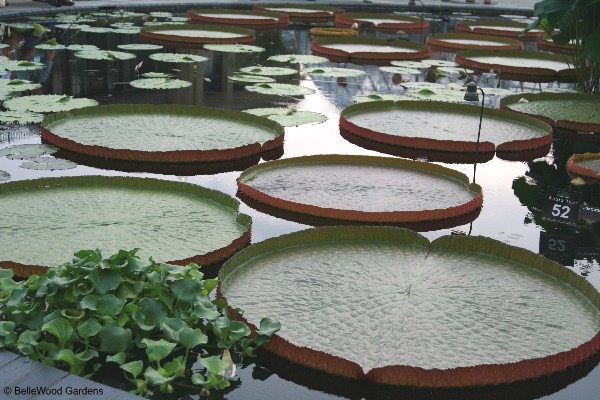
The aquatic plant that most fascinates the average visitor is this enormous annual, the water platter
or Longwood hybrid of the Victoria water lily, Victoria amazonica, and V. cruziana.
Difficult to believe something this huge could be an annual, of just one year's growth?
Read for yourself. Granted, seeds (which must be stored wet until they're sown)
are given an early start indoors and with extra warmth. But from January through July,
just seven months, you must surely agree this is still remarkable.
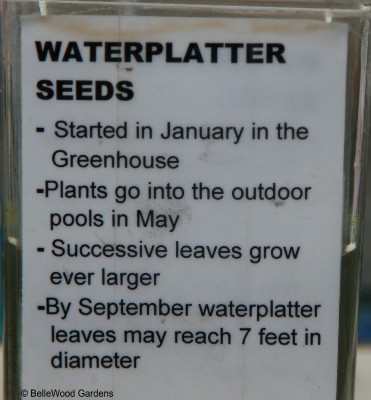
Having hybrid vigor, the Longwood Hybrid Victoria is said to be both easier to grow and more spectacular than either of its parents. It is the result of a close collaboration between George H. Pring (esteemed as the world's foremost breeder of tropical water lilies) from the Missouri Botanical Garden and his son-in-law, Dr. Russell Seibert, then Director of the Longwood Gardens. Mr. Pring was a consultant on water lilies when Longwood opened, and Patrick Nutt, from Kew Gardens, was engaged to grow tropical water lilies. Night blooming, the cross was made on September 17, 1960 at 9:30 p.m. using a freshly opened flower of V. cruziana as the female parent and a second day flower of V. amazonica as the pollen parent. A scant five weeks later approximately 275 seeds were collected a on October 25. And the rest, as they say, is history.
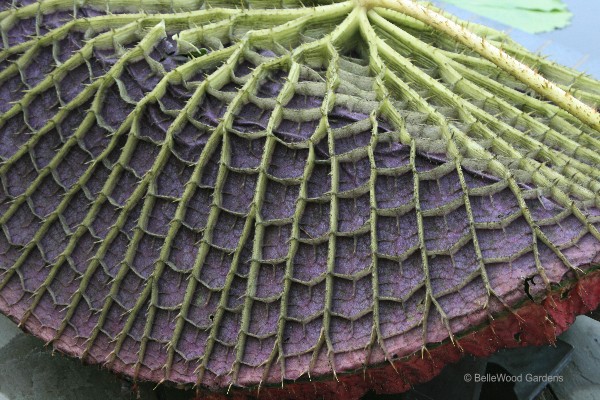
The water platter's leaves are so well designed that if their weight is distributed with a board,
a person weighing about 100 pounds can be supported by a leaf. Just see the , architectural
ribbing and reinforcement on the underside of this leaf that Tim Jennings brought out of the pool.
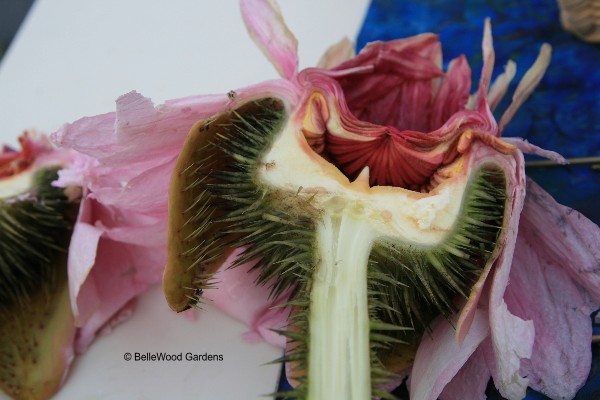
Edgar Anderson, in a Missouri Botanical Garden Bulletin article about Victoria water lilies
describes the flowers thusly, "The first night they open, their fifty or more oblong petals are pure white
and are held gracefully erect. During the next day they close up enough to have a tousled look.
The second night they are tinged with pink or red and eventually turn way back, the outer ones
lying on the water, forming blooms which are up to a foot and a half across." Night fragrant,
and with a pool of nectar in the bottom of the flower to reward the insects who come and pollinate.
Back to Top
Longwood Gardens in the Rain
July 23, 2008 with its tour of public and commercial horticulture in the Delaware Valley was a very interesting, very informative, very long day.
Here a garden, there a garden, add another two - and there you have our Wednesday. The general buses loaded and left around 6:45 a.m. I was on the earlier photographers' bus. We all saw all of the gardens, if not in the same sequence. For me it was first Chanticleer, then Conard-Pyle Company. Next, Scott Arboretum of Swarthmore College, and we all gathered together again at Longwood Gardens for more plants and garden and dinner. Hardy souls stayed for the after dinner fountain show, arriving back at the hotel about 11:00 p.m. Me? I took a seat on the early bus, nor was I alone. Besides, it was raining.

A rider in the rain. Someone who needed some assistance in getting around.

Unload the buses, through the visitors center (I didn't even stop
at the gift shop!) and walking, quickly walking toward the conservatory and
nearby gardens. Here on my left is the topiary garden, immaculately clipped and
guarded by two foo dogs. This is the female, with her paw holding down a puppy.
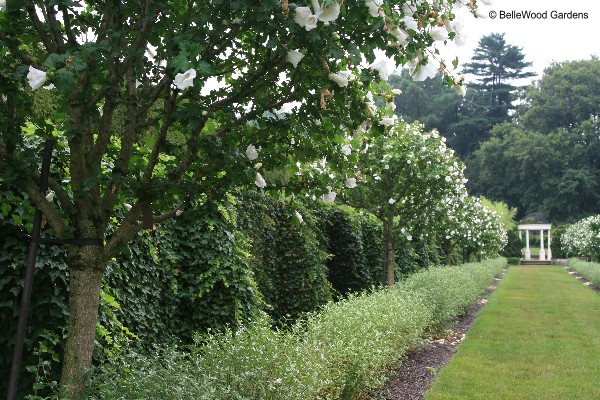
An alle� of white rose of Sharon, trained as standards. Probably
the cultivar 'Diana', a United States National Arboretum introduction.
'Diana' is distinct because it is a triploid with little or no seed production,
thus flowers freely from late June until autumn, plus flowers last for more
than one day. A graceful belvedere creates a beautiful focal point.

Gertrude Jekyll was very nearsighted, saw flower borders as abstract washes
of color. Almost the same effect here in the Idea Garden, with rain weighting down the flowers
and foliage, and adding a haze, a blurry scrim, to the overcast late afternoon.
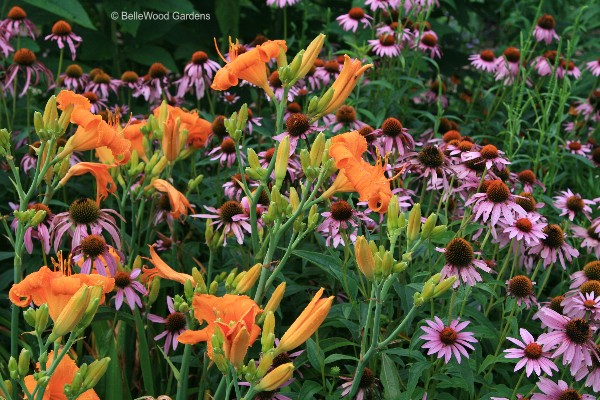
Some flowers still manage to explode with color, like this duo of daylily and
prairie coneflower. How nicely the vivid orange of the daylily picks up the more subtle
orange of the coneflower's central disc. Good combination. Nice design.
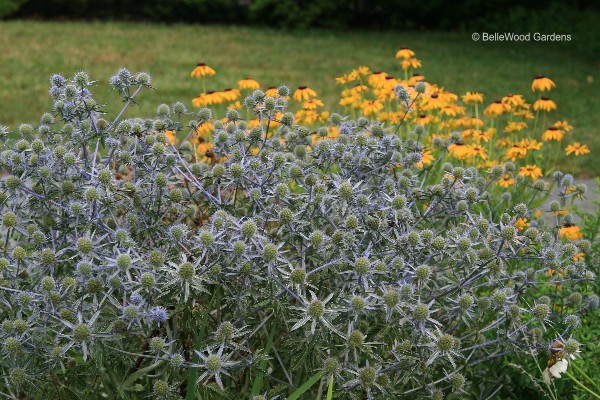
Or this pairing of Eryngium and a Rudbeckia. Charming in a
cottage garden, great in a prairie-style planting. Either one,
add some ornamental grasses to embellish the combination even more.

Pots, wonderful pots, in that electrifying blue that I associate with bonsai pots.
It's the color of the glaze that unifies the different shapes of these pots, and their eclectic
contents: water-loving lotus in the largest,central pot, and succulents from agave
and Aeonium arboreum 'Zwartkopf', and more.
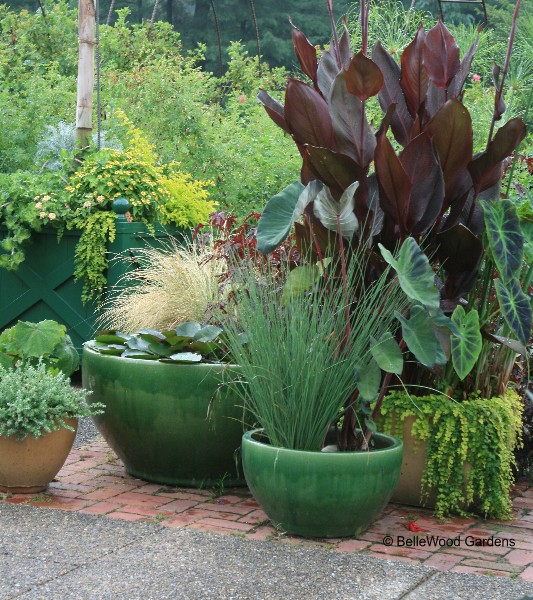
Ditto with these green glazed pots. Black leaved canna and golden
Lysmachia nummularia 'Aurea' trailing, and elephant ear 'Illustris' between
them. Actually, it's leaning in from an adjacent pot, with a feathery sketch of sedge
or maybe a rush? Need to run my fingers over it: sedges have edges
but rushes are rounded . . . . And the water lily in the huge pot. Even the
square wooden box with a palm erupting out of it, even that box is painted green.

A view of the mechanics of the fountains light show. A sequence of
colored lights to wash the water jets with a rainbow's hues. But only after dark.

And here we are at dinner, wining and dining with cachet in the ballroom
of the conservatory. A delicious buffet in superb surroundings, helped along with
beer and wine and convivial company. Doesn't get much better than this,
good food and a good time in a garden setting, with friends.
Back to Top
Green Roof at Swarthmore College
The day, which had begun with comfortable conditions, decided to show us what a July day in the Delaware Valley could really be like. So turn up the thermostat, crank up the humidity, and let's get hot and sticky. By the time we arrived at Scott Arboretum of Swarthmore College, I just wanted to plunge my hands and wrists in the tub of ice holding the beverages, thus cool my fevered blood. But the folks at the welcoming tend were asking us which green roof tour we wanted to get on, at 30 minute intervals and limited to 20 people. Clearly, everyone wasn't going to make it. But of course, I was among the fortunate few, had my hand out for a ticket almost before I knew what I was signing up for. Did it matter? Nah. It had something to do with plants. What else could I possibly need to know.
In August of 2004 a green roof was installed at Alice Paul residence hall, a 75 bed dormitory building. The 5,100 sq. ft. green roof (What's a green roof? Be patient, I'll get to that.) is an "extensive" system and cost $51,000 to design, for materials, to install, and for a leak detection system. This is not like when moss grows on the shingles of a home in the damp and drizzle-y Pacific Northwest. That's accidental and ruins the roof. This is on purpose, involving a green roof designer, a green roof installer, special plants, and some more companies and people.
Here's the deal: summer sun beats down on a roof, heating the structure. Crank up the air conditioning = using more energy. It rains. Water runs off the roof causing localized flooding (one inch of rain falling on a 10 ft. by 10 ft. roof area is the equivalent of 56 gallons), gets into sewers and is not environmentally sound. Reduced to an oversimplified description: a green roof has a waterproof membrane to keep the building interior dry, a special, mostly mineral substrate to support the growth of plants, and plants, mostly sedums and other succulents, that can grown in full sun and survive drought. Considerations - better to plan, design, and install when the building is under construction. A green roof weighs in at 15 to 30 pounds per square foot, while a traditional ballast roof weighs 11 pounds per square foot. Installation costs run $6 to $20 per square foot, so budget for it. On the plus side, a green roof extends the life of a roof by two or three times, by reducing temperature fluctuations and protecting it from UV damage. Environmentally sound, aesthetically pleasing, energy saving - green roofs are gaining ground here in the United States. The first one I ever saw was at the Floriade in the Netherlands back in 2002.
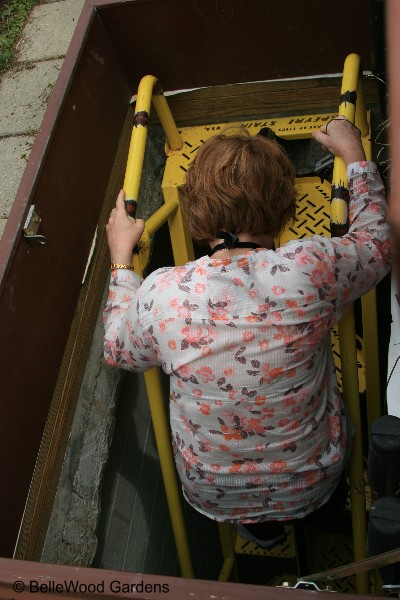
Our group collects in the residence hall's lobby and hears a brief lecture. Look at
some pictures of the installation and results. Walk up a couple of flights of stairs, then
one at a time climb up a rather steep ladder with odd half-width rungs to climb over
a combing and out onto the roof. Don't think there are any students in residence.
After all, it's summer and I guess most of them are back at home, on summer break.
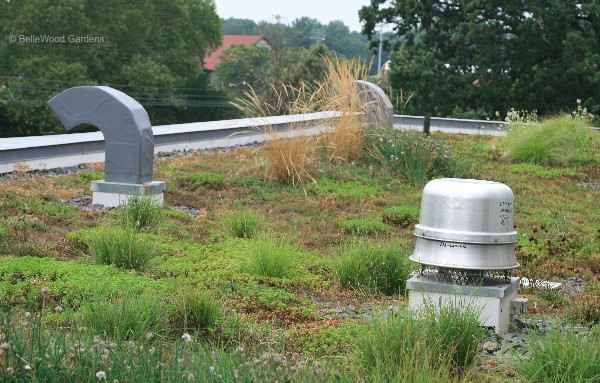
It's sort of odd, looking at typically rooftop ventilators sticking up out of the greenery.
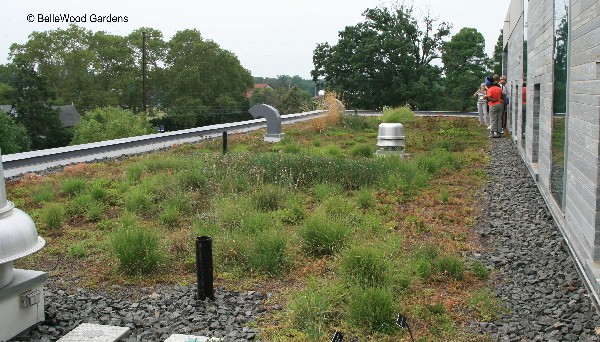
The green roof does turn the corner. Coarser stone against the building's wall and
around the HVAC pipes. Some of us did go and look over the edge but mostly we stayed \
close by the walls. Close together, too. Not much problem with weeds, just some spotted spurge.
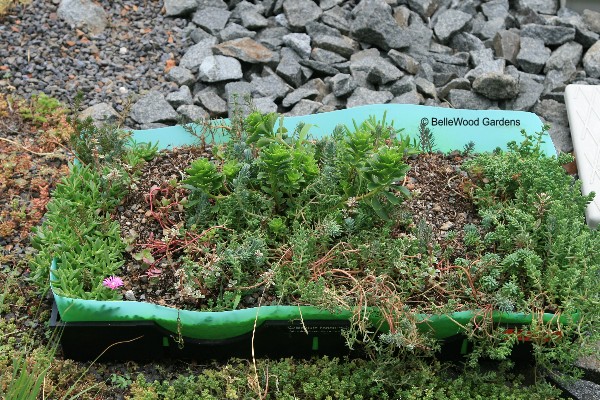
Here's a sample tray of plants ready to be plugged into a green roof.
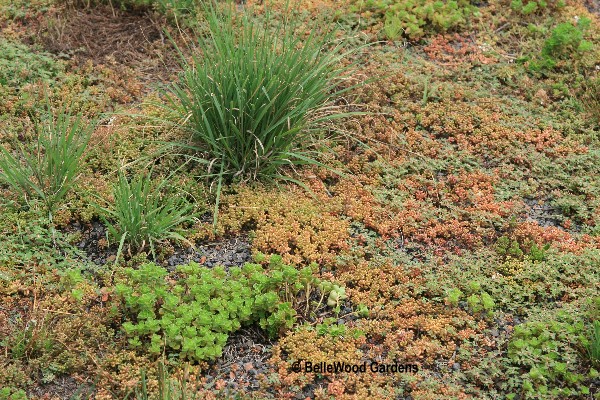
Some sedum is coloring up. Well, it has been rather dry lately. Another kind
is still looking fresh and green. The grasses had gone to seed and were recently clipped back.
They're doing even better than anticipated. Plants installed back in August 2004 include
Sedum album and also its cultivar 'Murale'. S. reflexum, S. sexangulare, also
S. spurium 'Fuldaglut' and 'Roseum'. The raised mounds with deeper root run
were also planted with a couple of small alliums, some dianthus, a couple of delosperma,
and talinum. Three grasses were also planted on the mounds. They included
Bouteloua curtipendula, Calamagrostis �acutiflora 'Karl Foerster' and
Sporobolus heterolepis. Fascinating. Must be a treat to have one of the rooms
with a window on the roof. Quite different from black tar, up on the roof in any big city.
Back to Top
Conard-Pyle's Perennial Plants
It was clear that Wednesday, July 23rd was going to be a long day. From Chanticleer our buses went to Conard-Pyle Company, in West Grove, Pennsylvania. They have extensive production fields there, and also test plots where rose plants from all over the world are also evaluated. The company is a distributor for Meilland, the prominent French rose breeder. First we toured the facilities. By bus. Edging our way down dusty roads past what seemed like a few thousand hoop houses. And this facility in Spring Grove, Pennsylvania is just one of three places where Conard-Pyle grows their plants - there's another Pennsylvania operation, and one in Maryland. All told, they are producing more than five million plants for the wholesale trade. It's not just roses either. True, from Peace to the ever-popular disease-resistant Knock-Out� roses, the Conard-Pyle Company has been renown for their roses for over a century. They even sold roses to Claude Monet (even if he is best know for his paintings of water lilies!) Today though, they also produce a wide range of woody ornamental plants. As a member of the Novalis Network, some simply stunning perennials. And what perennials! Talk about honest horticultural lust - I could envision just about every single one in my garden. Single? What am I thinking. You can't make drifts of one. More, I want more. What else is new, I always want more plants.
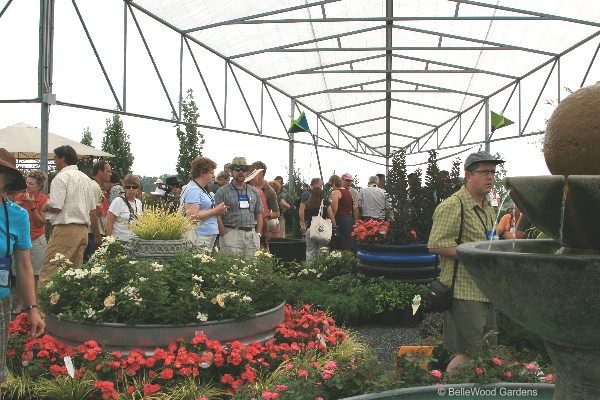
Off the buses and into the star-shaped display space.
Then squirm past everyone else ogling the plants,
attempting to get a good look and a clear image.
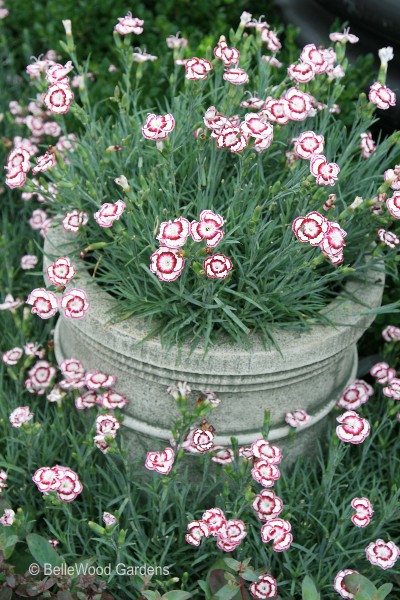
Dianthus 'Raspberry Swirl' is a sweetie. Pale and raspberry pink
when they first open, the flowers fade to white and fuchsia pink. Fragrant too.
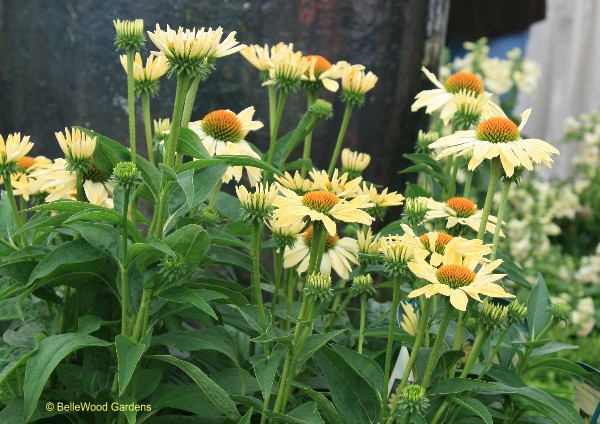
Remember when - like Henry Ford's model T that you could have in any color
as long as it was black, that is - prairie coneflower only came in crushed raspberry pink?
In case you haven't noticed, things have changed. Just look at Echinacea 'Sunrise',
which is one of the Big Sky series. A delicious soft, clear yellow it is, like its progenitor,
lovely in a cottage style garden, and great as a cut flower for summer bouquets.
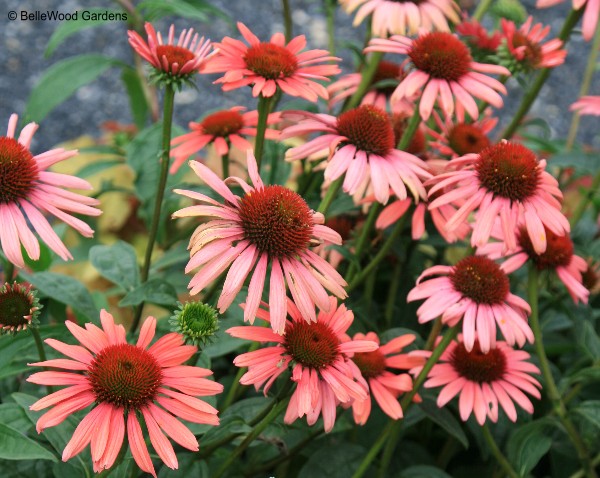
Pinks are tough colors to work with. Either they're a cool pink with a touch of blue,
or a warm pink softened with yellow. The two variations may both be "pink" but
they do not get along well together. Perhaps you just want a warmer pink than the straight species
has to offer. Another of the Big Sky series, Echinacea 'Twilight' is kicked up a notch
with just the most subtle hint of yellow. How does that do it for you?
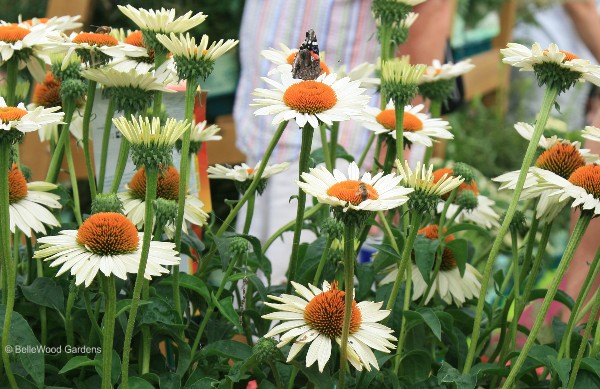
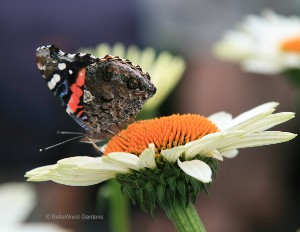
Much as I appreciate Echinacea 'Fragrant Angel' (and clearly I'm not alone)
I cannot find much fragrance in its flowers. Could be several reasons: my sniffer is fatiguing, perhaps
the fragrance is specific to a certain time of day and this visit wasn't when the odor is released,
or maybe the fragrance is specific to a certain stage of bloom, either young or more mature.
I'll just have to grow some and then go out into the garden early and late and smell the flowers.
For sure, the double row of white petals and warm orange center pay rent for space in the garden.
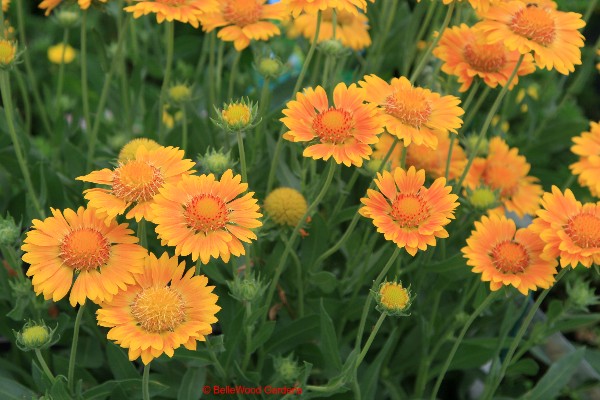
I love marmalade. Make it myself, even searching out Seville oranges for classy preserves.
Here's a wonderful new gaillardia that's sure to become a popular addition to gardeners' palette.
Long-flowering, from late spring into summer, Gaillardia 'Oranges and Lemons' starts off
with orange petals and a deep red-orange disc, fading to yellow-tipped petals and golden yellow disc.
The result is a shimmering variation as new blossoms open and older ones mature. Nice!
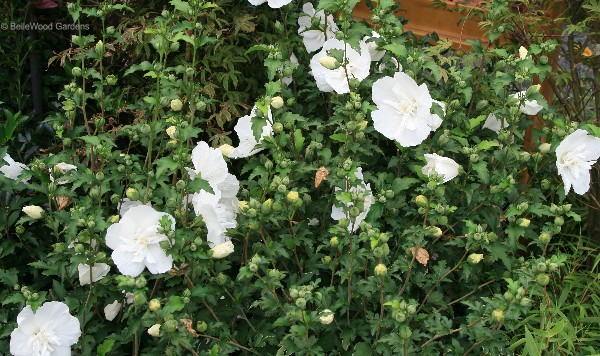
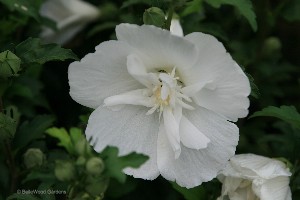
Hibiscus syriacus used to be this weedy bush (wouldn't even dignify it as a shrub)
that grew in city gardens, littering the ground with fallen blue-lavender flowers
and prolifically self-seeding even in the neighbors' yards. Hibiscus 'White Chiffon'
is a shrub of a different kind. Do you believe the bud count! Awarded a silver medal by
the Royal Boskoop Horticulture Society, the shrub adorns itself with large white flowers
embellished with a lacy white center from July through September. Elegant, for sure.

There are a zillion daylilies, with more released every year. With all that competition,
new cultivars have an uphill struggle to stand out amid the competition. Hemerocallis 'Moonlight Masquerade'
might just do it for you, with warm creamy petals on 5- to 6-inch diameter flowers washed with saturated
deep burgundy markings set off with a green throat. Not my style, but I can surely admire it in the abstract.
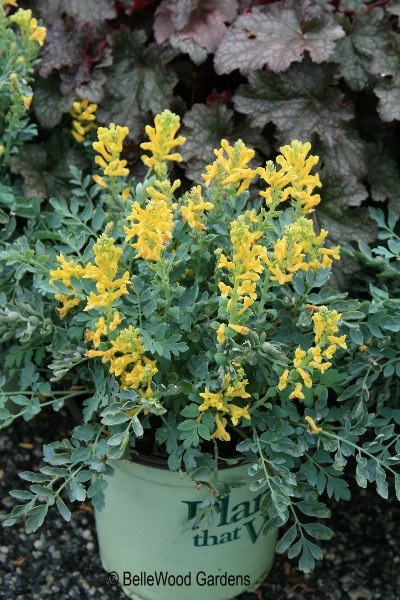
Here's where I fell in love. For me, this plant has it all, with superb foliage and
good flowers, and best of all - roll out the red carpet - Corydalis 'Canary Feathers'
is a woodland plant. This is going to be, heck, this is a fabulous addition to the shady garden.
Cool glaucous blue lacy foliage stays through summer. Bright yellow flowers shine in the shade.
Smirk. I have two plants. Tag suggestions are to combine 'Canary Feathers' with blue or yellow hostas.
I paired mine with glossy yellow-y green hosta 'Fried Green Tomatoes' and Japanese forest grass,
Hakonechloa macra 'Aureola'. Another option would be Brunnera 'Jack Frost' with its
ace of spades shaped silver leaves, or a pulmonaria cultivar such as 'Cotton Cool' or 'Excaliber'
with their silver leaves. Alas, 'Canary Feathers' is a sterile hybrid of two species. I need to buy more . . . .
Back to Top
PPA Media Award
Allow me to blow my own horn. I received a letter last month, informing me that "The Perennial Plant Association is pleased to announce that Judy Glattstein has been selected to receive the 2008 Perennial Plant Association Garden Media Award. This award recognizes an individual whose educational and promotional efforts have resulted in a heightened awareness of perennials and the perennial industry. Certainly Judy Glattstein's writing, teaching, and lectures have fostered gardening and gardening with perennials to the public and horticultural professionals alike. She is to be congratulated on a notable achievement."
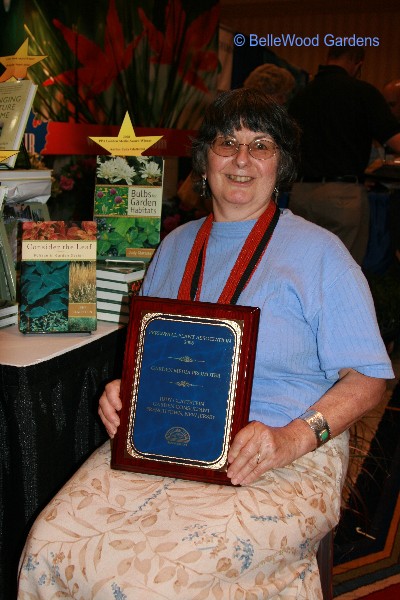
Photograph Credit Emma Alpaugh, all rights reserved.
The Special Award was presented on Tuesday, July 22nd at the 26th Perennial Plant Symposium
Here I am at the Timber Press booth at the trade show. Happy, happy. Can't you tell?
Emma sold a fair number of my books, which I happily autographed (at no additional charge [grin])
Why me? I assume it's because I'm a popular instructor at the New York Botanical Garden, also teach personal enrichment classes on a variety of garden subjects at Rutgers Gardens in New Brunswick, New Jersey; the Leonard J. Buck Gardens in Far Hills New Jersey; and the Frelinghuysen Arboretum in Morristown, New Jersey. In addition, I lecture across the United States and abroad for professional organizations and garden clubs.
Printwise, I'm the author of eight gardening books - three on bulbs, one on shade gardening, one on water gardening, two on using foliage for garden design, and one on Japanese plants. I've also written for numerous magazines including Cottage Living, Real Simple, Garden Design, and others.
I've received other awards, including the Garden Writers Association Quill and Trowel Award of Excellence, and the Quill and Trowel Certificate of Merit.
It is a wonderful feeling when recognition is given by your peers for doing what you love.
Back to Top
Chanticleer, Have a Seat
Chanticleer loves its visitors. They're welcome to walk on the grass, and rustic, Adirondack style, chairs are set up here and there about the grounds. Overcome by the beauty of the plants and gardens, you can plop into a chair and enjoy the ambience and landscape.
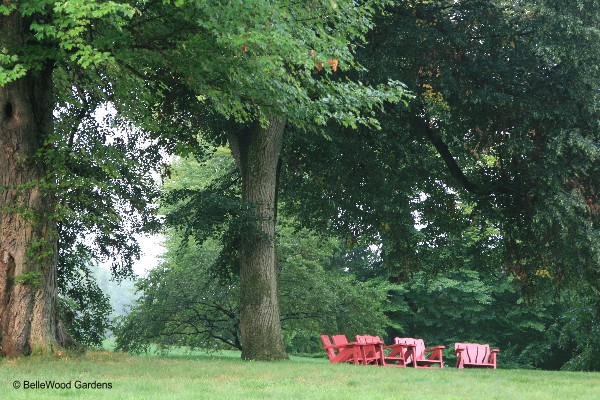
A group of red chairs, set beneath towering trees, make a delightful place
for several friends to discuss the pleasures and delights of Chanticleer.
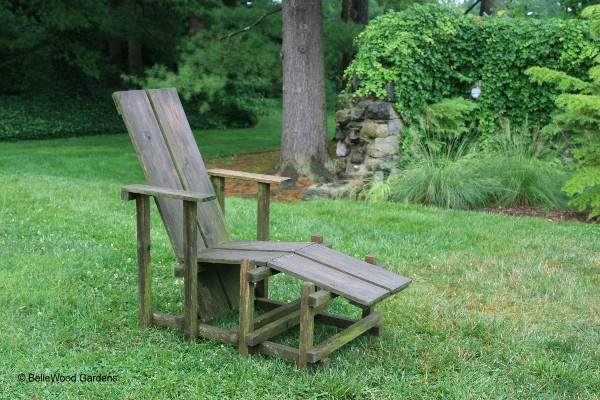
A single, weathered chair harmonizes with the bark of a nearby tree.

A pair of bright chartreuse green chairs offer seating by the lotus pond.
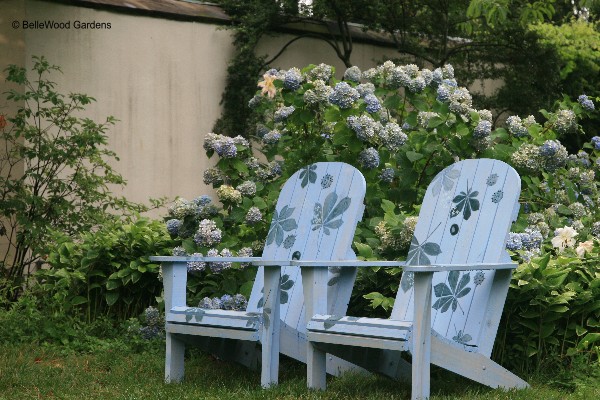
Soft sky blue chairs with a tracery of horse chestnut leaves stenciled on their backs,
seats, even the arms, are accenting the hydrangeas in bloom behind them. Clearly, Kristen is enjoying herself.
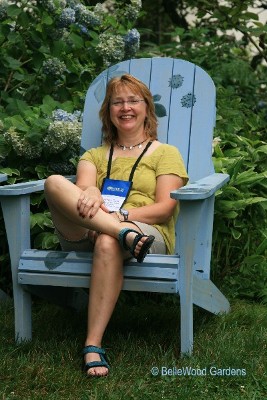

Vivid leopard-spotted chairs, perhaps ready to pounce across the lawn.
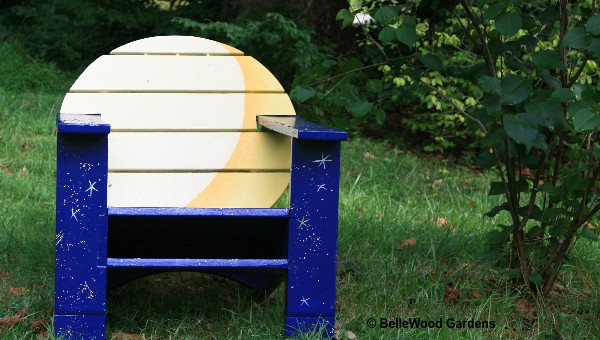
Maybe my favorite, a wonderful moon and stars chair.

The forecourt to the house, red gravel elegantly raked in Zen dry stone garden style.
Two blue chairs . . . . but you'd have to tiptoe on the coping to get to them.
.
And one that cannot be shifted about
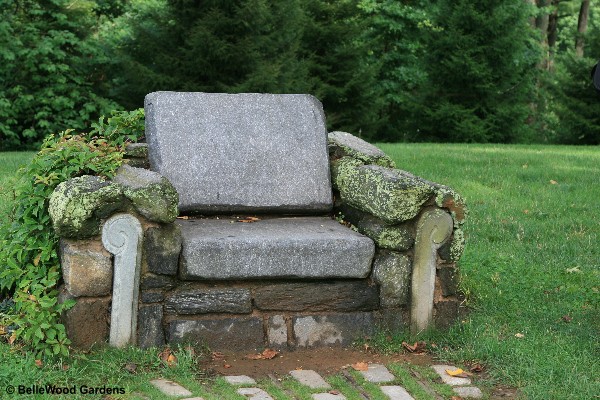
a stone chair. There's a matching love seat too. But I doubt
it is as comfortable as the overstuffed club chair it resembles.
Back to Top
Chanticleer, In the Wet
When we were house-hunting here in New Jersey a dozen years ago, Paul told our real estate agent that I'd no doubt prefer a property with water on the grounds. Glory Ann nodded her head, and proceeded to show him two with in-ground pools, one with a hot tub on the deck, and another with a view of Spruce Run reservoir. We ended up here at the property I named BelleWood Garden, which has an intermittent drainage creek occasionally flowing near one side.
As you might expect, Chanticleer does it better.
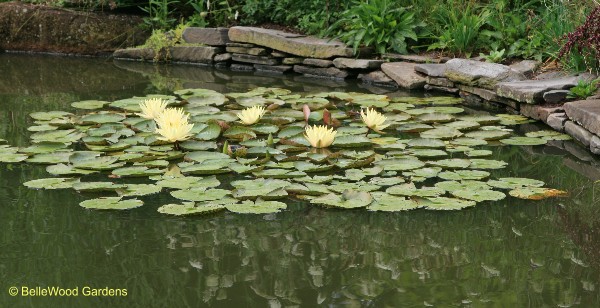
There is the pond garden with water lilies
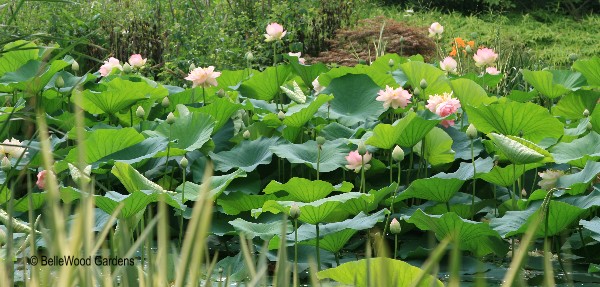
and lotus in bloom.
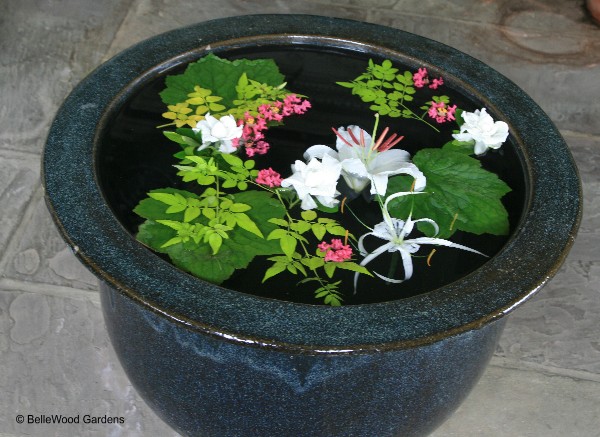
The sun porch has a bouquet of flowers and foliage afloat in a glazed container.
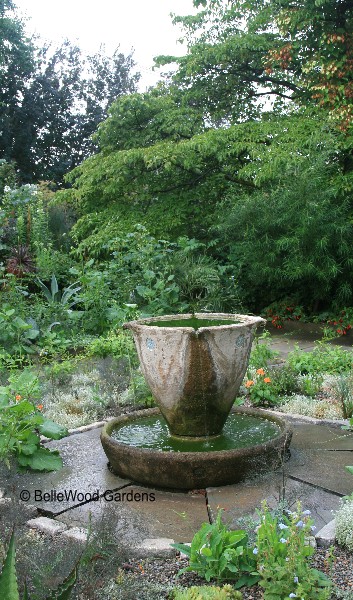
In the Teacup Garden there's a subtle fountain, water quietly trickling from four small spots.
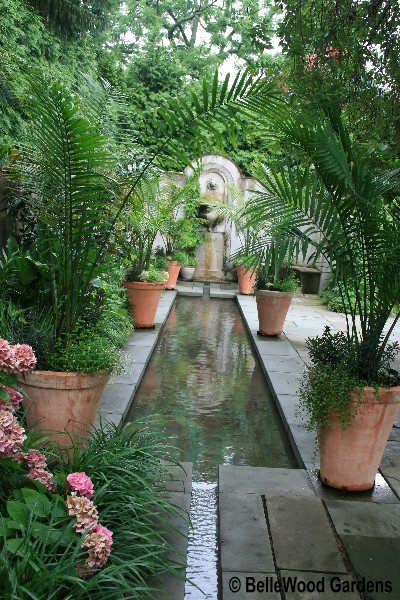
It becomes more elaborate, with the Moorish influenced rill and reflecting pool.
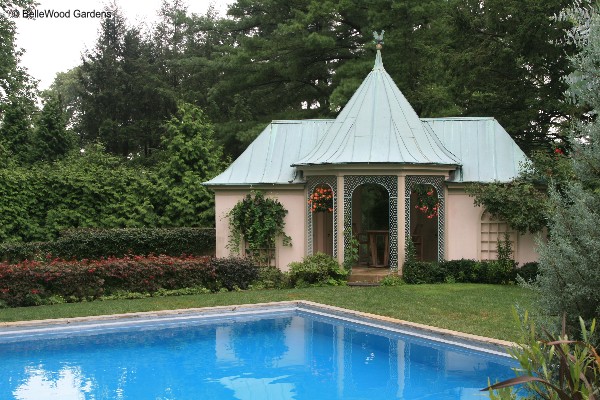
The swimming pool becomes a landscape feature, anchored with two little buildings
(one is seen here) for changing in and out of bathing suits.

In the Ruin Garden there is a Pool Room, where water sheets and splashes and flows
over parti-colored marble faces gaze up from the depths of another fountain.
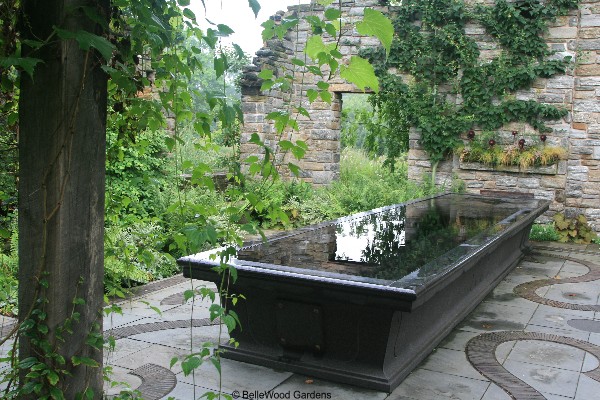
Also in the Ruin Garden is a great hall with a mosaic of tile, granite and slate,
a fountain shaped like a large black sarcophagus. Water seeks its own level
and here, its perfect plane forms a mirror to the sky, the structural ruins, and the plants.
Back to Top
Chanticleer
Did I but live closer, Chanticleer would have me as a more frequent visitor than the intermittent trips I manage to accomplish. Originally known for its majestic trees and verdant lawns, today - a mere 15 years since it opened to the public in 1993 - the there is whimsy and playfulness and color with fabulous plant combinations, lush containers of tropical foliage and others with succulents, texture and color and pizzazz. Garden rooms and courtyards frame combinations of hardy and tropical perennials, trees, shrubs, vines, and bulbs. A hedge of asparagus frames a cutting garden that is larger than the attractive kitchen garden. (Got to get your priorities right.) There's a serpentine of agronomic crops (this year it's sorghum) undulating through a mown hillside.
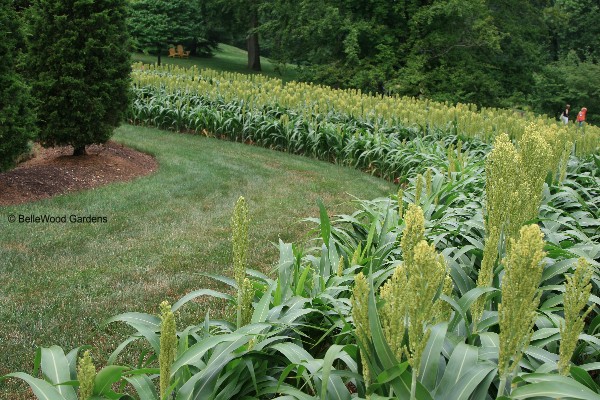
Gardens, as you no doubt know, are especially wonderful early and late, first thing in the morning and at dusk. So given the opportunity to sign on for the early, the photographers bus, I did. It was scheduled to depart at 6:00 a.m. We were there, so was the bus, but departure was delayed. No matter. We got to Chanticleer, and I only had to cope with 40 or so people wandering in front of my camera at inopportune moments, rather than three or four bus loads.
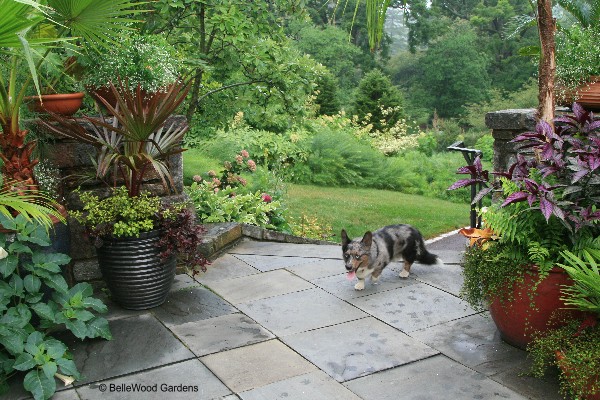
Our welcoming committee

Chanticleer's visitors' boothy with maps and information available.
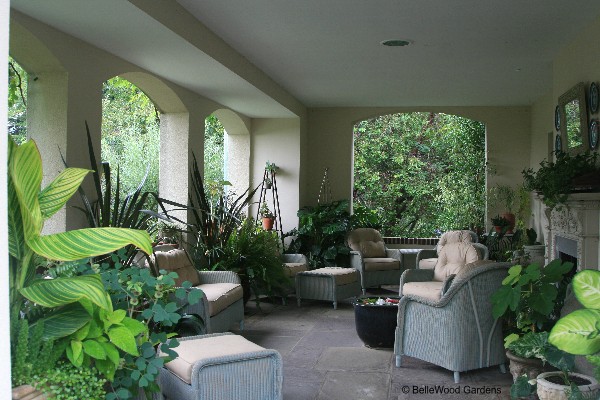
The sun porch (should be called, as Dan Benarcik said, "The shade porch.")
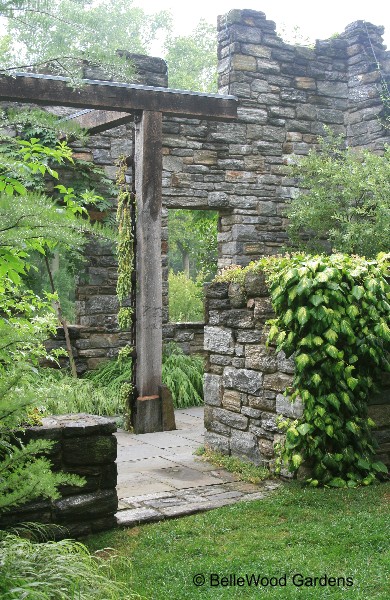
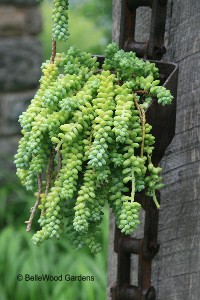
Minder House was razed and construction of the Ruin Garden began in 1999.
The plan was to use the partially dismantled house as the ruin,
but for safety reasons only the foundation and the tile "rug" remain
from the original structure. It is a wonderfully evocative space.
Don't you like the whimsical use of some old farm equipment chain
hanging down the wooden post and its scoops used to grow donkey tail sedum.
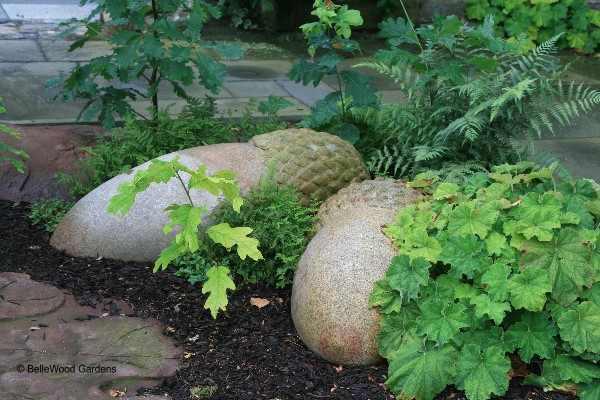
Little oaks from big acorns grow in the Ruin Garden.
Also look at Chanticleer, In the Wet
and scroll down to enjoy images in the Pool Room,
of marble faces in a fountain and
a slow flowing black sarcophagus fountain
that should be in the hall of the mountain king.
.
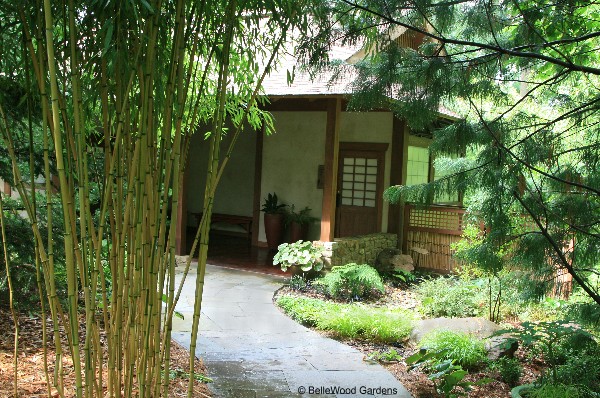
And this attractive Asian style building, nestled amongst bamboo and evergreens?
Bathroom. It's a bathroom. Isn't it just exquisite. Look at the sheltering engawa. Almost makes you
hope for rain, to stand beneath the sheltering roof and listen to the water droplets splatter down.
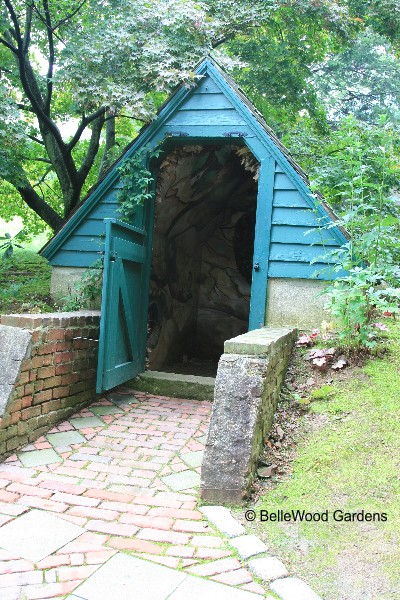
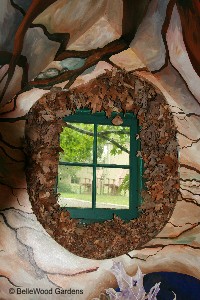
And here - what's this? Perhaps a spring house. Let's take a look . . . .
We're underground. At least it looks that way. And the window and the door
are framed with dried up oak leaves.
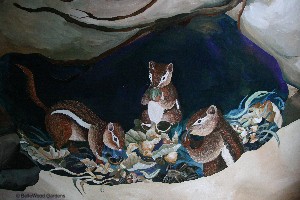
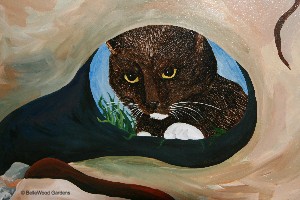
There are some chipmunks, feasting on acorns. And peering down a knothole is a curious cat.
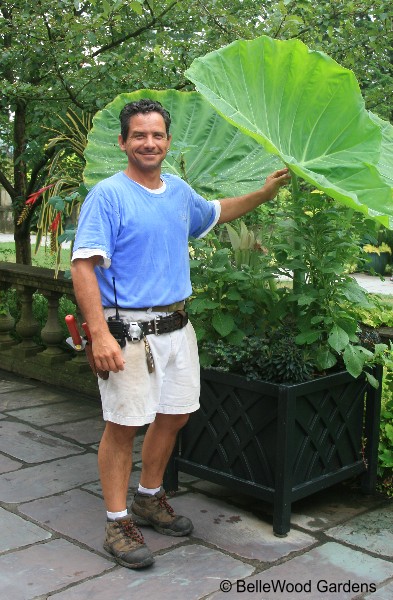

Here's Dan Benarcik, mastermind of the fabulous containers up by the house.
He's practically sheltering beneath Colocasia gigantea Thailand Giant strain
on the Chanticleer House terrace. Funky flowers, don't you agree?
Back to Top
A Center City Community Garden
There's a problem with bus tours, especially those with buses big enough to accommodate 40 or more people. They are limited as to where they can go and where they can park. So on Monday, 21st July, we're on the pre-conference tour with an agenda and scheduled stops, and the bus captain casually mentions that we're passing a very nice rain garden, another rain garden, a community garden - and I'm doing everything but release the emergency window in order to evacuate the bus and have a closer look. That didn't happen, but later in the evening, thanks to Marilyn who gave me and three other people a lift, I managed a visit to the community garden.

I mean really, if you saw this fanciful fence surrounding a full city block
with garden plots filled with vegetables and herbs and flowers and stuff,
I mean, like, really, wouldn't you want to stop off there? I know I surely did.
The Spring Garden is at 18th and Wallace Streets in Center City Philadelphia. They started breaking ground and picking out the rubble from recently bulldozed housing in 1995. The debris was carted away and a layer of topsoil brought in, thanks to their local councilman. The following year the group received a grant from Philadelphia Green, a program of the Pennsylvania Horticultural Society. The funds enabled The Spring Garden to purchase soil materials and wood to build the raised beds on the property.

By now things are well organized: there's a community compost heap,
a separate pile for bricks and stone and stuff, and a huge heap of top soil with a big sign
"This topsoil is now available for use in individual gardens. Hep Yu Sef!"
A quick aside here: Philadelphia Green, the nation's largest urban greening program, uses horticulture to build community and improve the quality of life in Philadelphia's neighborhoods and downtown public spaces.
So Allison and Bonnie and Kyle and me started walking around the block. There's a gate on each side, but they were locked. We could see a few people inside, and we started yoo-hoo-ing. Eventually someone came over to see what the fuss was about. Our possibly confusing explanation - "We're here for a plant conference, and our tour bus came by the garden today but they wouldn't stop. We just had to come back and see your garden. We thought since it's a community garden some people would be here working around dinner time and they'd let us in." And they did.

So here's a nice view of part of the garden. Over 165 families garden here every year.

Plot sizes range from 10 feet by 10 feet for beginners up to 20 feet by 20 feet.

The average size is 10 feet by 20 feet. They have two picnics every summer,
with a diversity of wonderful food fresh from the garden, prepared with recipes
from their very diverse inner-city neighborhood.

Nor do they wait just for the picnics. This happy fellow,
having walked across the street, was clearly going to enjoy
having his dinner in the garden.
The community of gardeners gives back too, through the City Harvest Program.
This a unique partnership between Pennsylvania Horticultural Society;
the Philadelphia Prison System; and SHARE, a food cupboard distribution network.
Inmates raise seedlings in a recently-refurbished greenhouse at the prison in Northeast Philadelphia.
Volunteer gardeners in a network of participating community gardens and in the prison�s
Roots to Reentry garden grow vegetables from the transplants. The produce is distributed
to food cupboards throughout the city,providing naturally-grown vegetables to Philadelphians
who lack access to fresh produce or lack the resources to purchase it.

.

There's time and space for more than growing plants. This plot
belongs to a young couple. Maybe newlyweds, I was told. Their hammock
is a getaway from city streets to a countryside filled with fruits and flowers.

A child blows soap bubbles in front of water barrels while her grandmother
works in the City Harvest plot, gathering yellow summer squash and beets.

And the bamboo grove along the fence not only provides stakes and bean poles,
it provides some privacy and a touch of the tropics for the modern equivalent of an outhouse.
.
A great outing. Good garden, nice people, pleasant time.
Well worth the walk back to the Sheraton at 17th and Vine.
Back to Top
John Bartram and His Garden
The pre-conference tour on Monday, 21 July included (among other stops) a visit to John Bartram's Garden. Who is he? John Bartram was born in Darby, Pennsylvania in 1699. A self-taught early American botanist and horticulturalist, Carolus Linnaeus called him the greatest natural botanist in the world. So how did a plain Quaker farmer with no formal education beyond the local school become reknown in the world of horticulture?
John Bartram had a lifelong interest in medicine and medicinal plants, and read widely. As his friend Ben Franklin said, "An investment in knowledge always pays the best interest." His botanical career began on his farm, land purchased in 1728 along the banks of the Schuylkill River near Philadelphia. Along with crops typical of that time and space, he used a small area for cultivating plants he found interesting.

His house, built of the local stone, was enlarged several times to accommodate his growing family.

As a hobby, and for relaxation, John Bartram carved stone, creating the columns and window framing seen here.
In 1733 Peter Collinson sent a request to John Bartram for "plants of interest." It was probably James Logan, William Penn's secretary, who suggested this. Collinson, also a Quaker, was a cloth merchant trading with North America. That was his vocation; his avocation was gardening. Through his business contacts he obtained samples of seeds and plants from around the world. His personal plant collections, first at Peckham and later at Mill Hill, became famous.
Realising that there was a market for such things in England, in the late 1730s Collinson started importing North American botanical seeds for English collectors. In 1736 he began financing John Bartram's travels, who - assisted by this financial support - travelled extensively in the eastern American colonies collecting plants from Lake Ontario in the north, to Florida in the south, and the Ohio River in the west. Bartram's Boxes, as they became known, contained seeds and sometimes dried examples of foliage. Collinson distributed these New World seeds to British gentry, nurserymen, and natural scientists.

Bartram's study, much as it might have looked in his day. The flabby brown thing on his desk
is an ox bladder, the 18th century's equivalent of our zip-lock plastic bags.
It was used for sending seeds and plants when shipping them abroad.
In 1765 King George III appointed John Bartram The King's Botanist, a position he held until his death in 1777.

Knowing that Bartram was of relatively modest means, Collinson urged him
to dress appropriately for important meetings, so as not to reflect badly on Collinson.
Clearly, Kirk Brown took this under advisement when choosing his apparel for
Philadelphia Botanical History, presented by John Bartram, presented to the PPA
on Tuesday, July 22nd. It was very well received and given enthusiastic applause.
Perennials at Bartram's Garden

Bartram was possibly introduced to water chinquapin, Nelumbo lutea,
by the indigenous North American tribes who used the tubers and seed for food.
As well, it is a beautiful addition to the water garden, as we saw it growing
in a charming moderately sized pond during our tour of Bartram's Garden.

Allegheny spurge, Pachysandra procumbens, could also have been a Bartram introduction.
For sure, its now-ubiquitous Japanese cousin, P. terminalis, would not have been around.

Bergamot or Oswego tea, Monarda didyma, would likely have been grown in herb gardens
for its use as a tea plant. I wonder though, how did the colonists cope with its susceptibility to mildew.
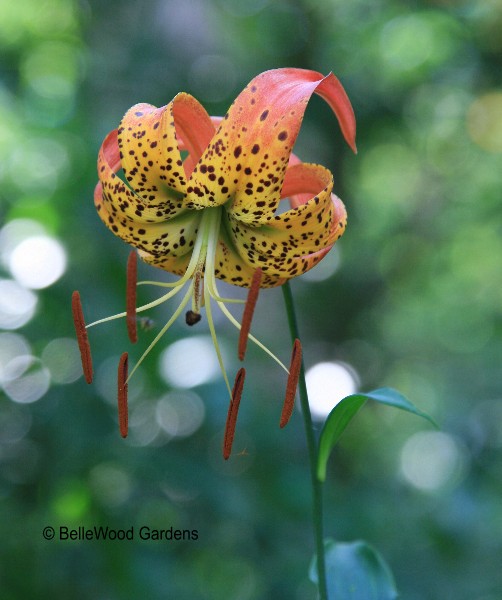
Seen here at Mt. Cuba, turk's cap lily, Lilium superbum, is one of our loveliest natives.
Collinson apparently thought so too, growing it in his garden at Mill Hill, outside London.
In a letter to Bartram dated September 20, 1736 he writes, " I have the pleasure to tell thee that
the Noble Marsh Martigon Flower'd with Mee which thou sent this spring. It is a delicate Flower."
In a letter written in 1756 to John Frederick Gronovius, author of Flora Virginica
Collinson happily reports "This moist year . . . .I had the Giant Pensilvania Martigon figur'd by Mr. Ehret
that grew Eight foot five Inches high with 12 Flowers on it which made a Glorious Show."

His reference is to an illustration made by Georg Dionysus Ehret in 1744, then
engraved by Seligmann for Christoph Jakob Trew's Plantae selectae (Nuremberg: 1750-53).
John Bartram sent it to Peter Collinson, who successfully flowered it in his garden, after which
it was painted by one of the world's finest botanical artists and published in a book still reknown today.
Names change and taxonomy bedevils us: his Giant Pensilvania Martigon was then known
as Lilium Martagon canadense and today is named Lilium superbum
Arguably, unquestionably, the most reknown of John Bartram's discoveries is the tree
he named for his friend, Ben Franklin. Had it not been for Bartram and his son Billy, we'd never know of it.
In 1765, while botanizing along the Altamaha River in Georgia, the two men discovered a small grove.
Billy subsequently brought some seed back to the garden and successfully propagated it. The last time
Franklinia alatamaha was seen in the wild was 1803. All the trees now extant are descendants
of the seeds Billy packed home in his saddlebags. And this is not an easy tree to grow.
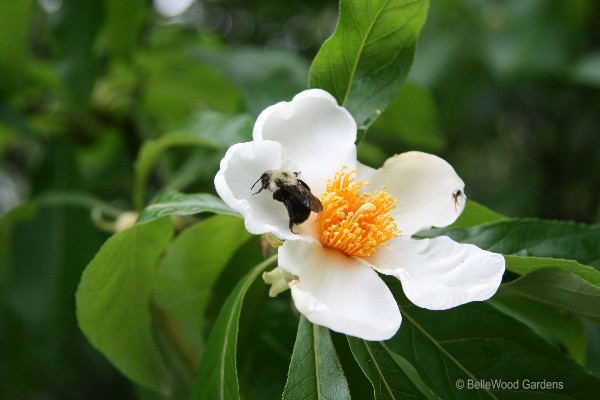
Happily, at the Scott Arboretum of Swarthmore College, there are some mature specimens,
and lovely in bloom when we were there on Wednesday, July 23. Pristine white flowers
surrounding a boss of golden stamens, clearly popular with bees. I have a young seedling
that was the distribution gift plant at Rutgers Gardens Spring Plant Fair in May. It's been potted on,
and looks vigorous. I'll keep it protected over winter, then plant it out next spring. I'll amend the soil
with compost, and toss in some ferrous sulphate to ensure it is acid. Water well, then pray over it.
And perhaps this time, the wonderful tree found by John Bartram and his son Billy will thrive in my garden.
Back to Top
Street Scenes
I'm off to Philadelphia for the 60th annual symposium of the Perennial Plant Association. There will be a good turnout of members from across the United States, Canada, some from France, others from Germany, also the Netherlands. We'll visit the Delaware Valley's "must see" gardens of Longwood Gardens and Chanticleer, other gardens, more gardens, garden centers, and attend lectures, visit the trade show, socialize, and have a grand time.
Since I'm close enough to drive, I decided on a leisurely departure. Good thing there was no plane to catch, so leaving an hour and a half later than planned was not that serious. At least all the container plants were watered. So I drove off mid-afternoon on Sunday, 20 July, with great expectations and in anticipation of a wonderful time. Right on both counts.
Philadelphia is a city, intimidating to one such as myself, more accustomed to a road with unpaved portions and the occasional escape of my neighbor's sheep wandering across to sample the greener grass on the other side.
.

There are grand boulevards, such as this view from the steps of the art museum.
Tree-lined grand concourse, towering buildings, distant vistas of fountains,
and classical bronze statuary. (Yes, there's also one of Rocky at the museum steps.)

Logan Square (which is round, but that's its name) is just a couple of blocks from the Sheraton Hotel.
One of the five original squares planned and laid out on the city's grid, it is a popular open-space park.
Children were splashing around, and swimming in the fountain is a long-standing Philadelphia tradition.
Swann fountain memorializes Dr. Wilson Cary Swann, founder of the Philadelphia Fountain Society.

Adapting the tradition of river god sculpture, Alexander Calder created large Native American figures
to symbolize the area's major streams, the Delaware and Schuylkill Rivers, and the Wissahickon Creek.
Punning on Dr Swann's name is the maiden with an agitated, water-spouting swan, represents the Wissahickon.
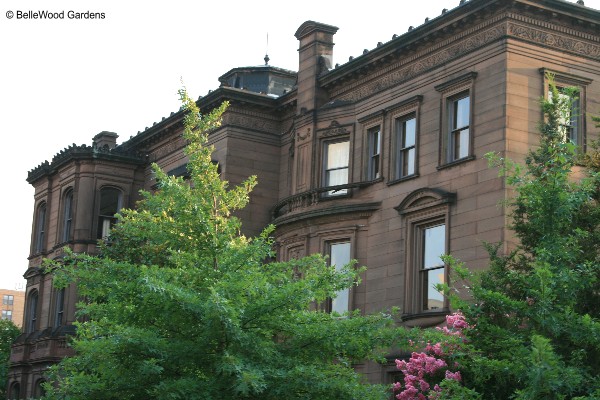
Evening walks along the streets near our hotel offered much to enjoy such as this brownstone mansion.
Once an elegant family home, it had been converted into several apartments. I managed to find this view
which avoids air conditioners inserted into windows. They provide necessary comfort but were rather ugly.
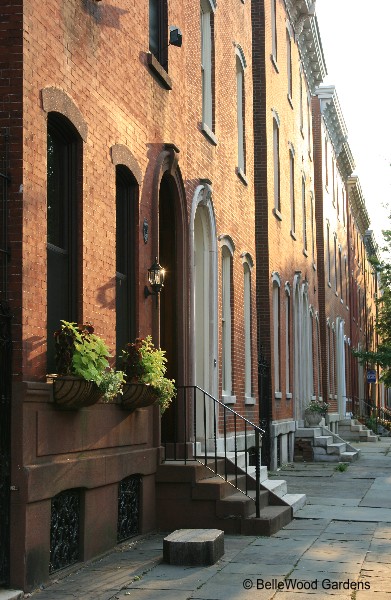
Evening sunlight gilds the brick row houses and slate sidewalks.
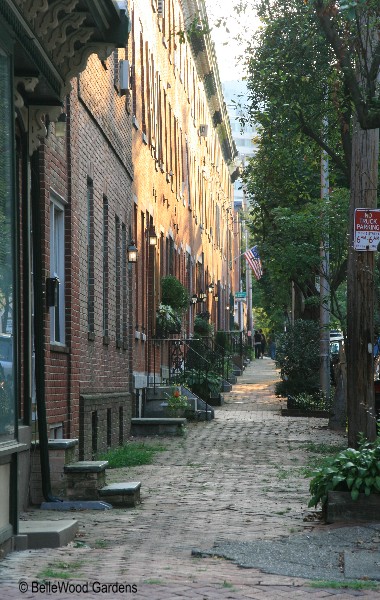
Another street, this one with brick sidewalks, is embellished with greenery -
some rather handsome window boxes, potted plants at the stoop, and street trees.
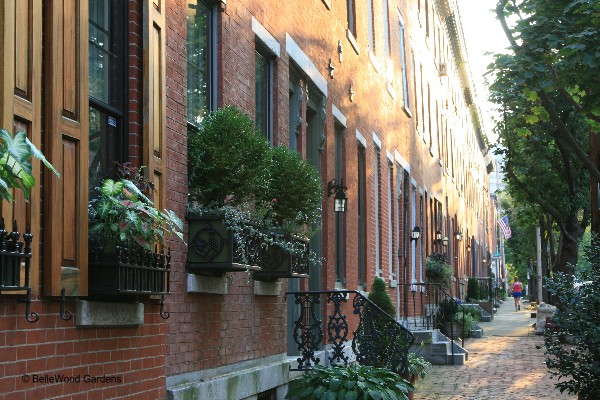
Here's a better view as I walked down the street with my friends.

But city streets create a tough life for plants. Look at this tree's roots,
as confined and deformed as any Chinese woman's bound feet.

Throughout Philadelphia we saw wonderful, colorful murals such as this one.
Over 20 years ago the city began a Mural Arts Program as part of an initiative to eradicate graffiti.
Mural artist Jane Golden was hired to reach out and redirect to graffiti writers to mural-making.
There are more than 2,700 murals throughout Philadelphia, more than any other city in the world.
Back to Top
Back to the main Diary Page











































































 are in bloom.
are in bloom.



































































































































































